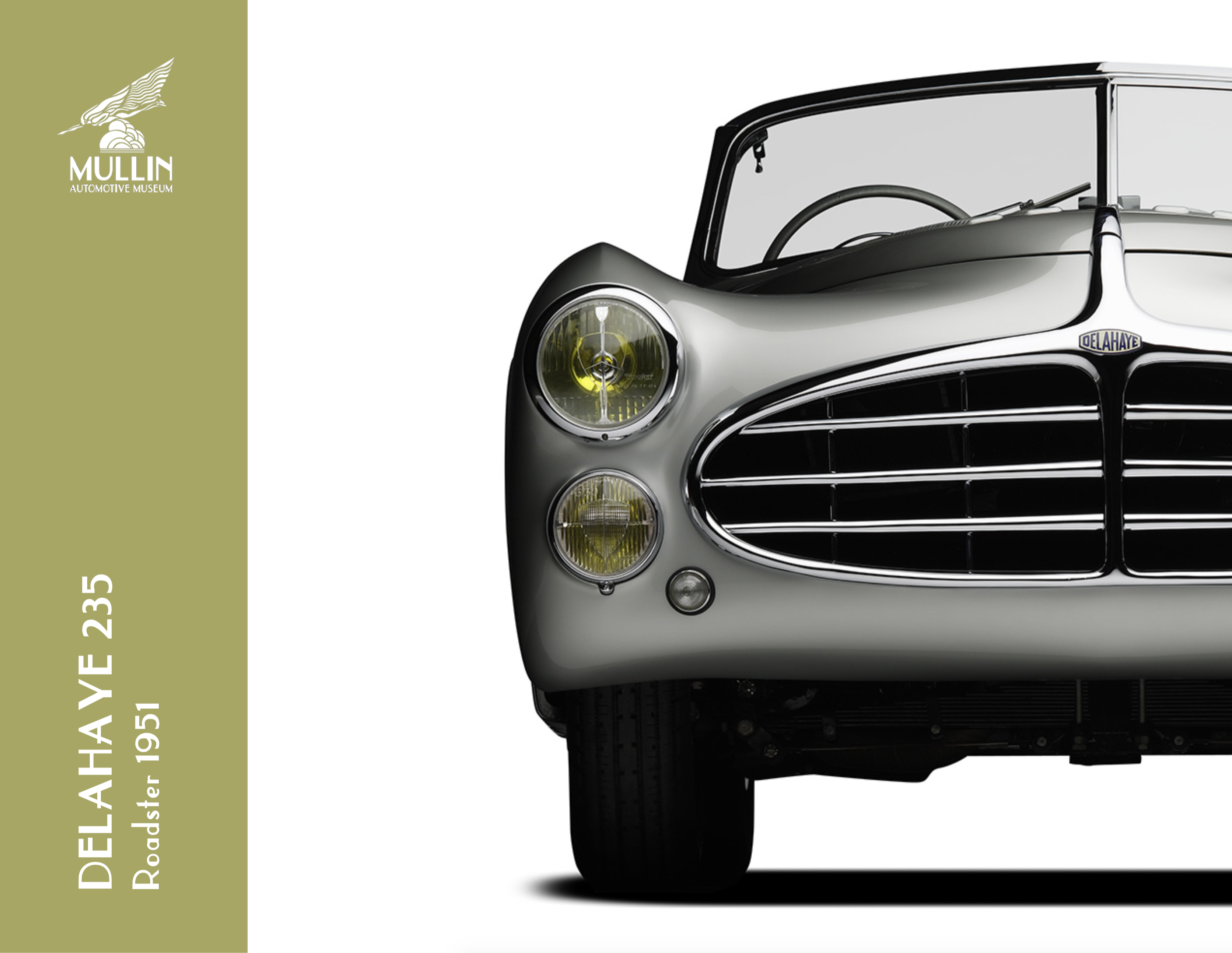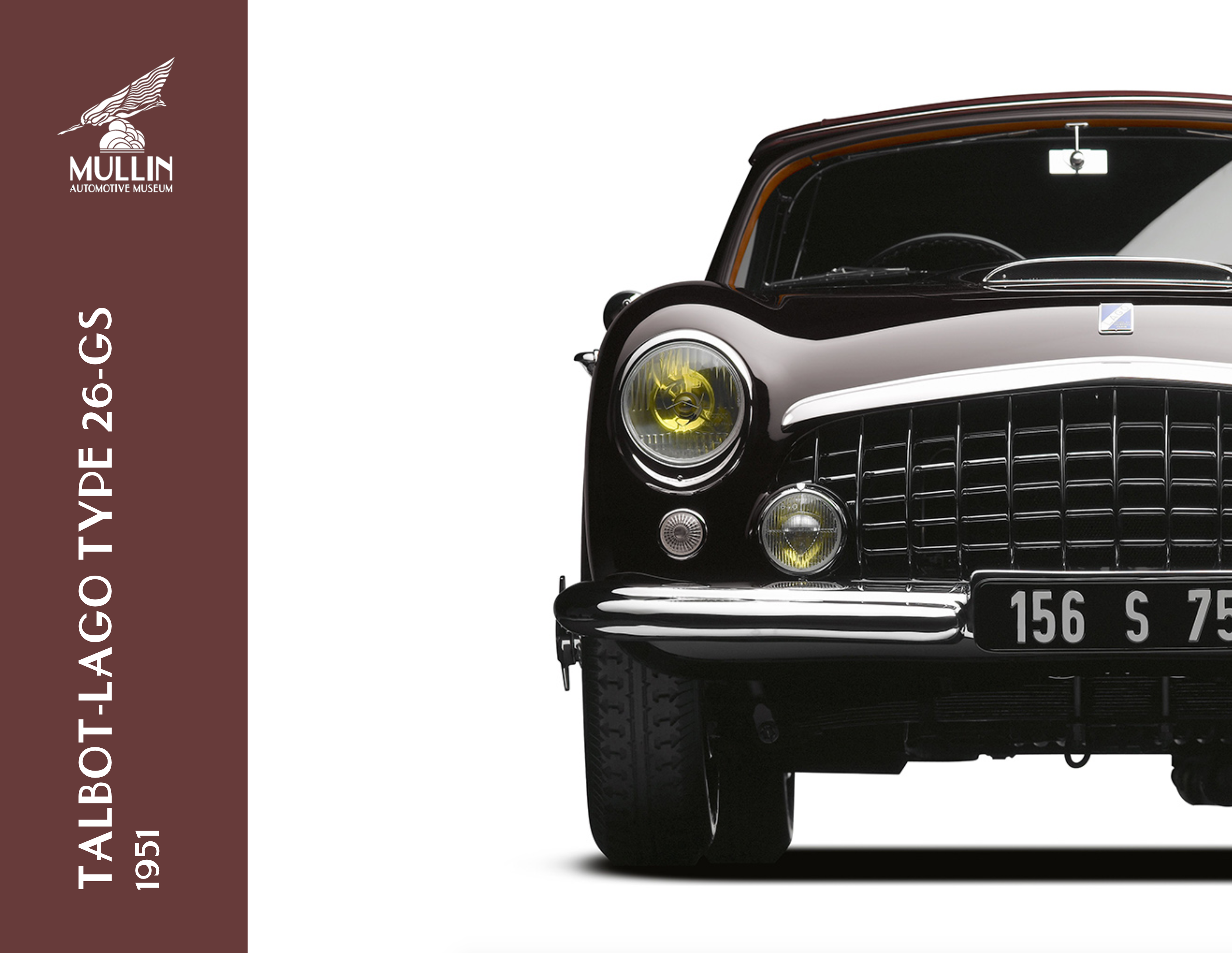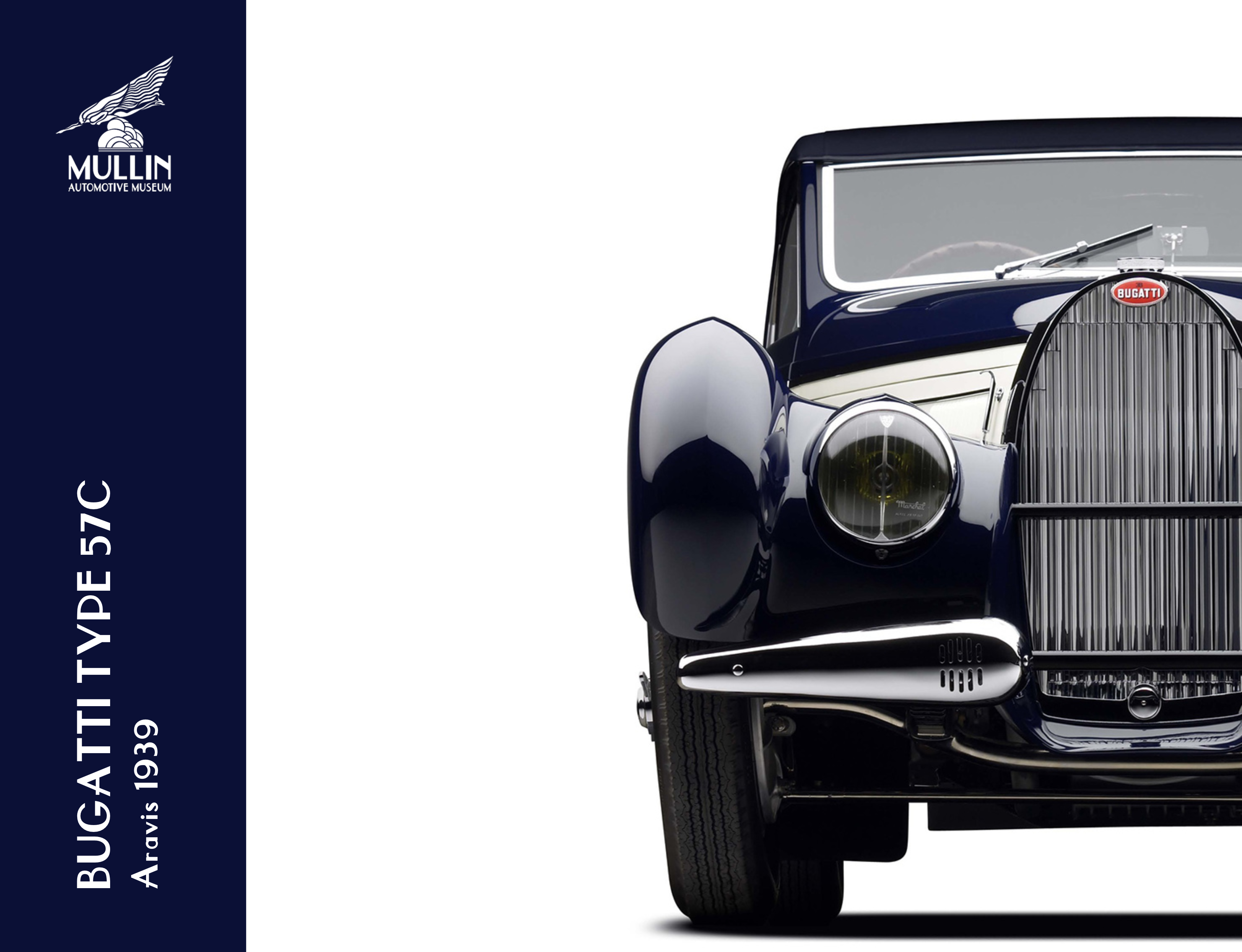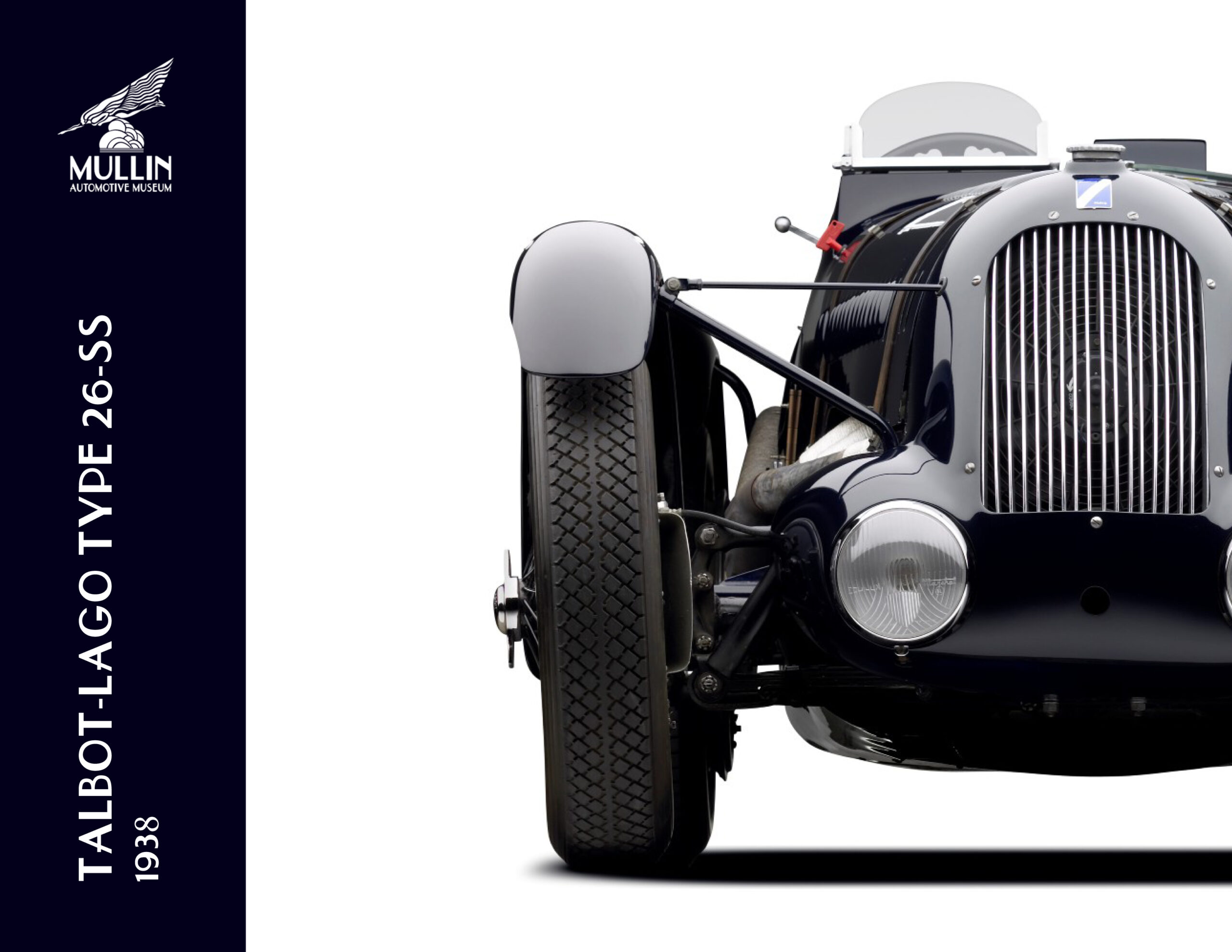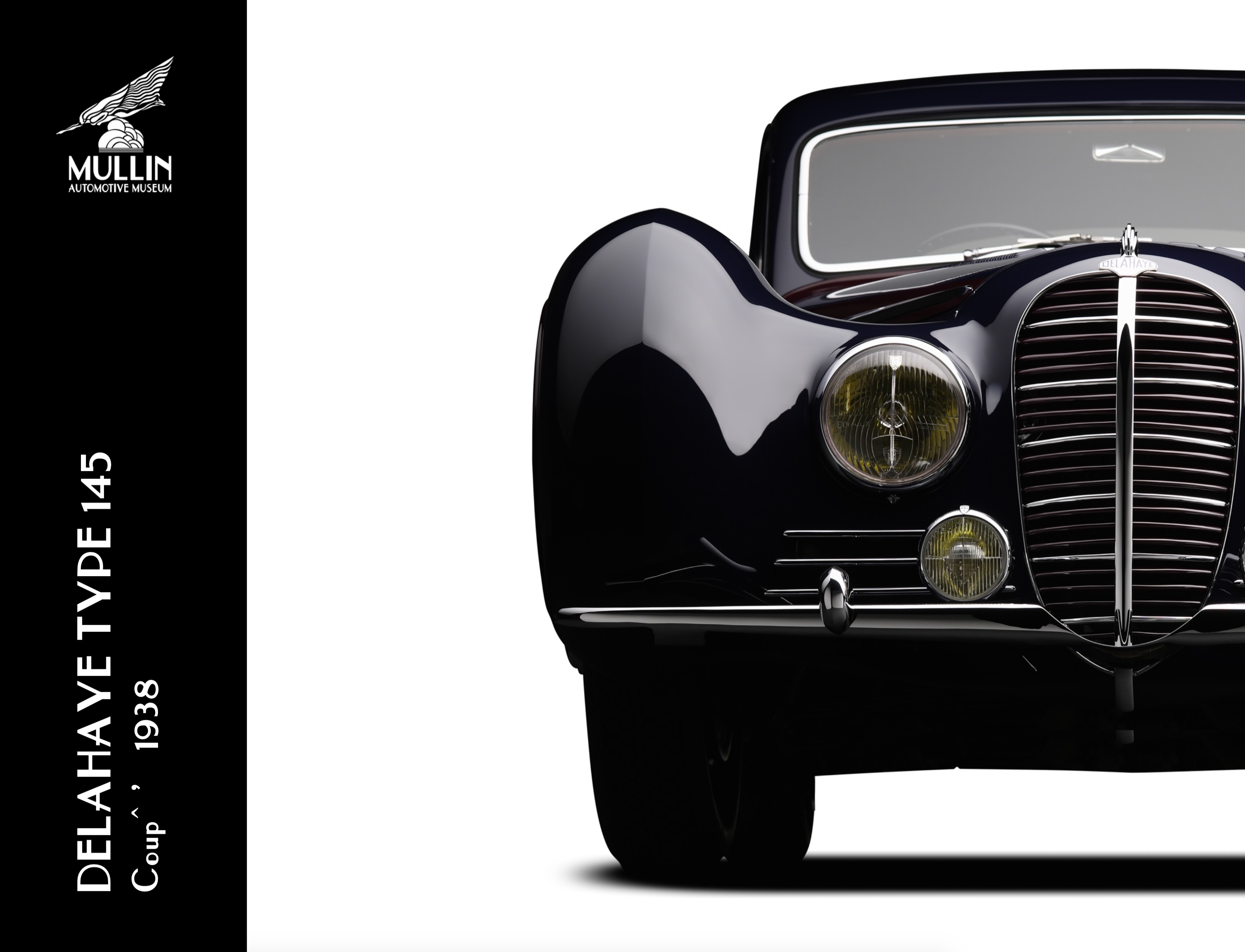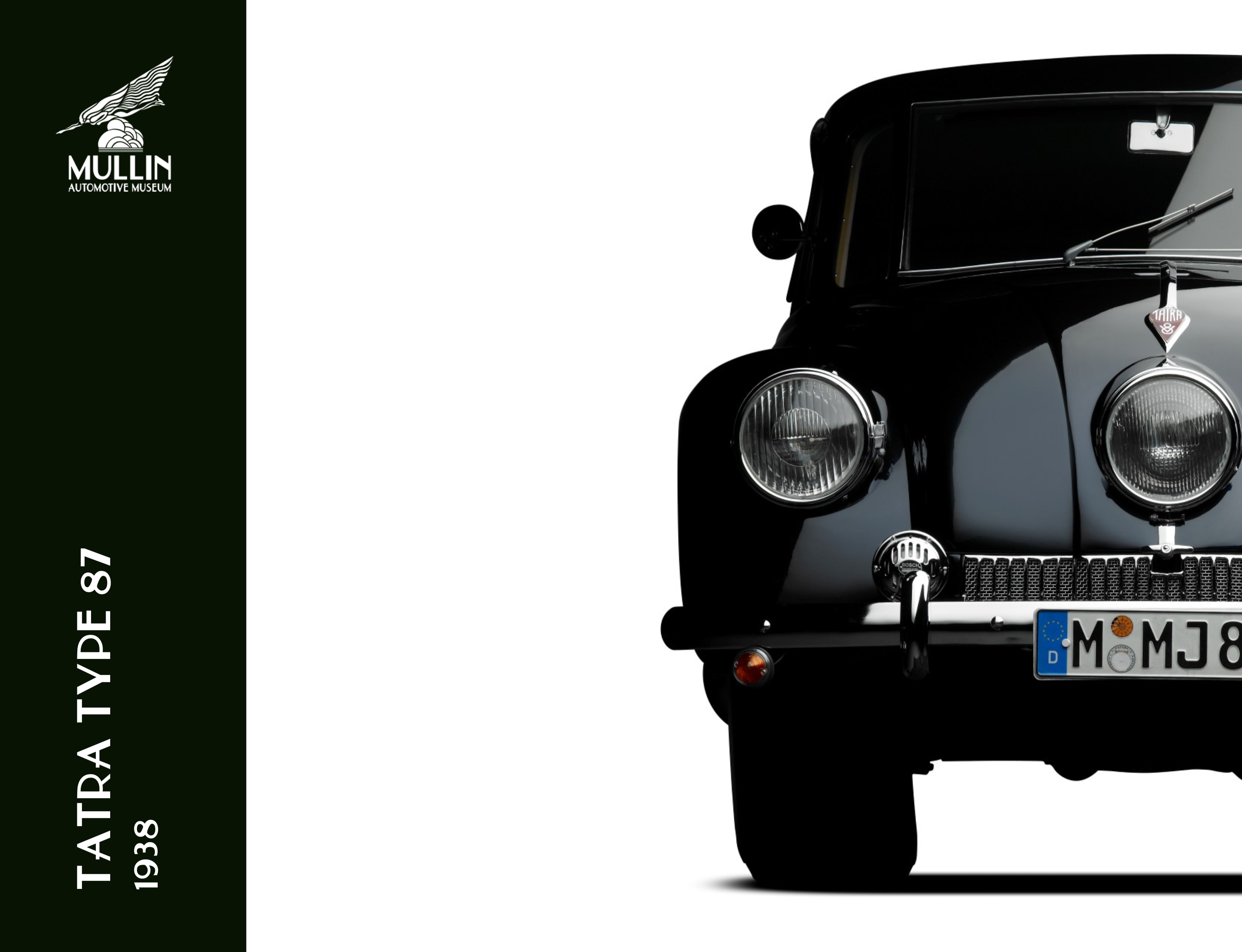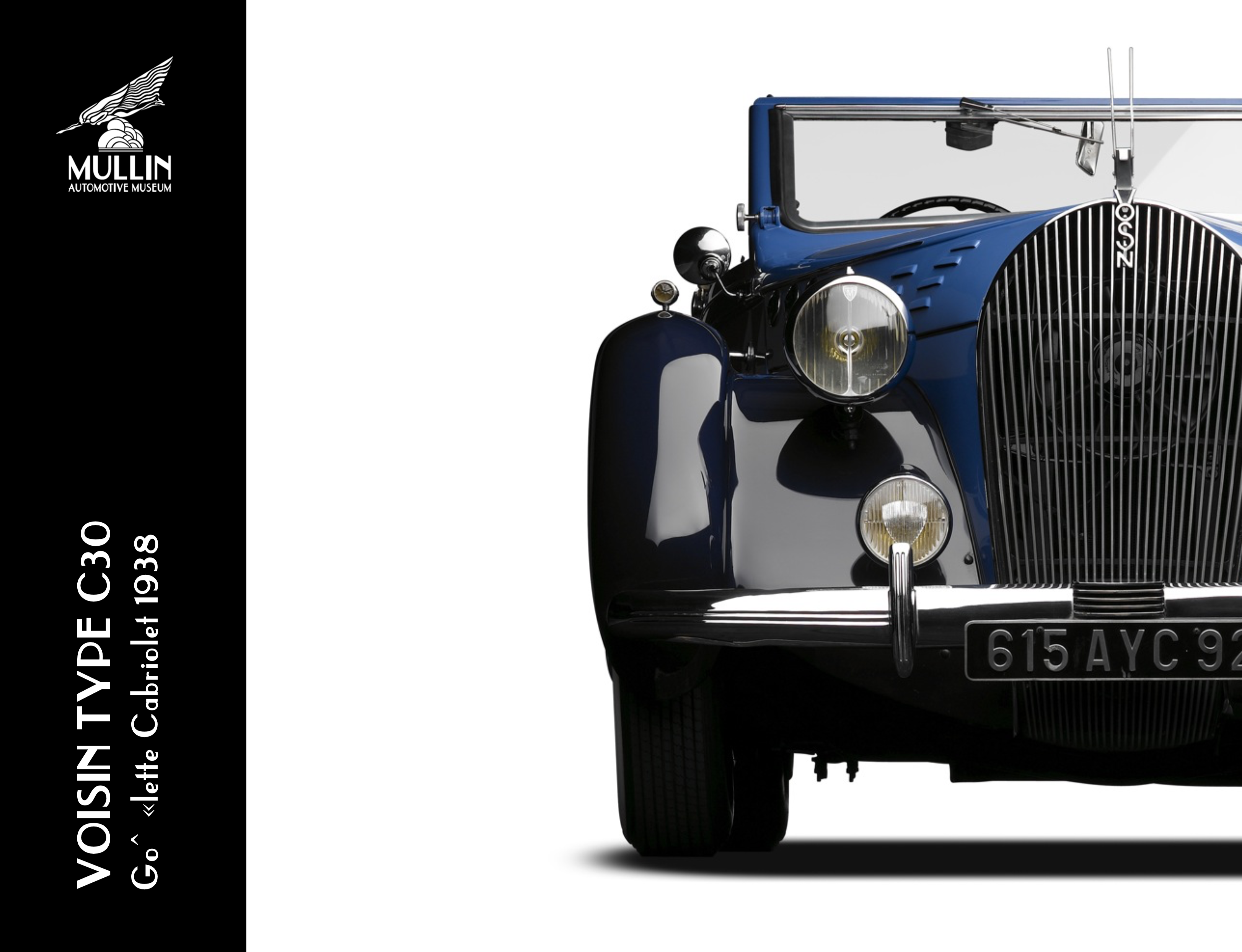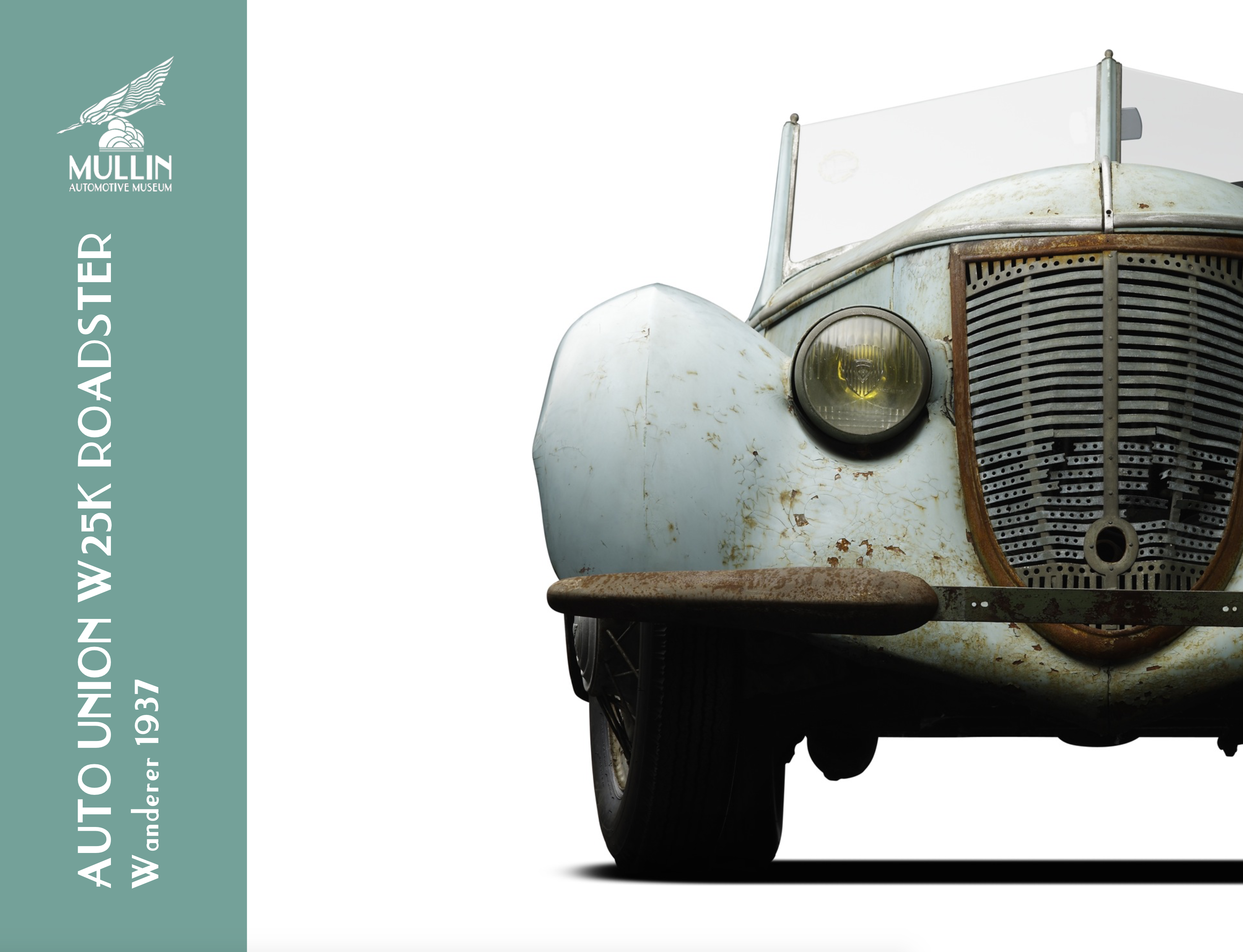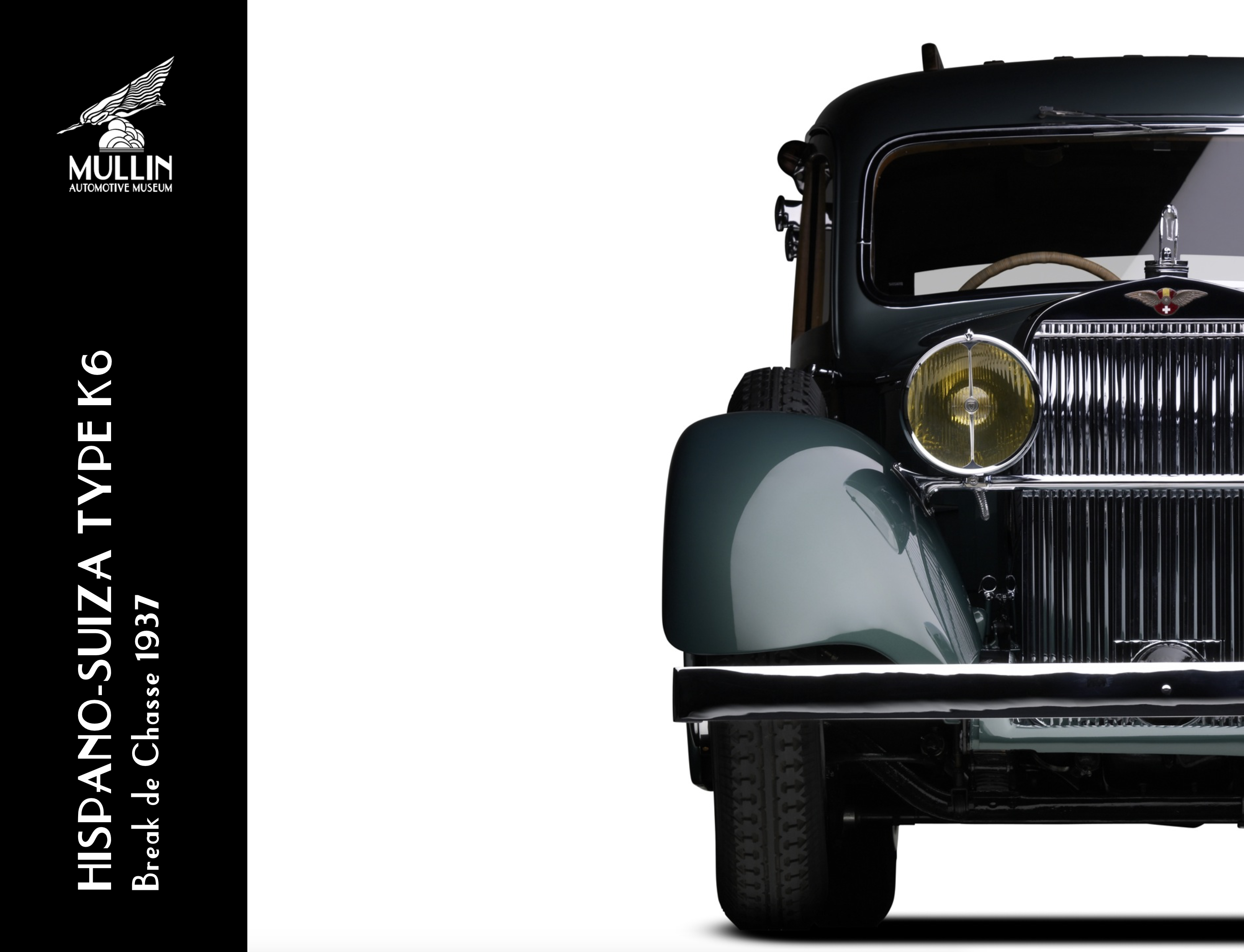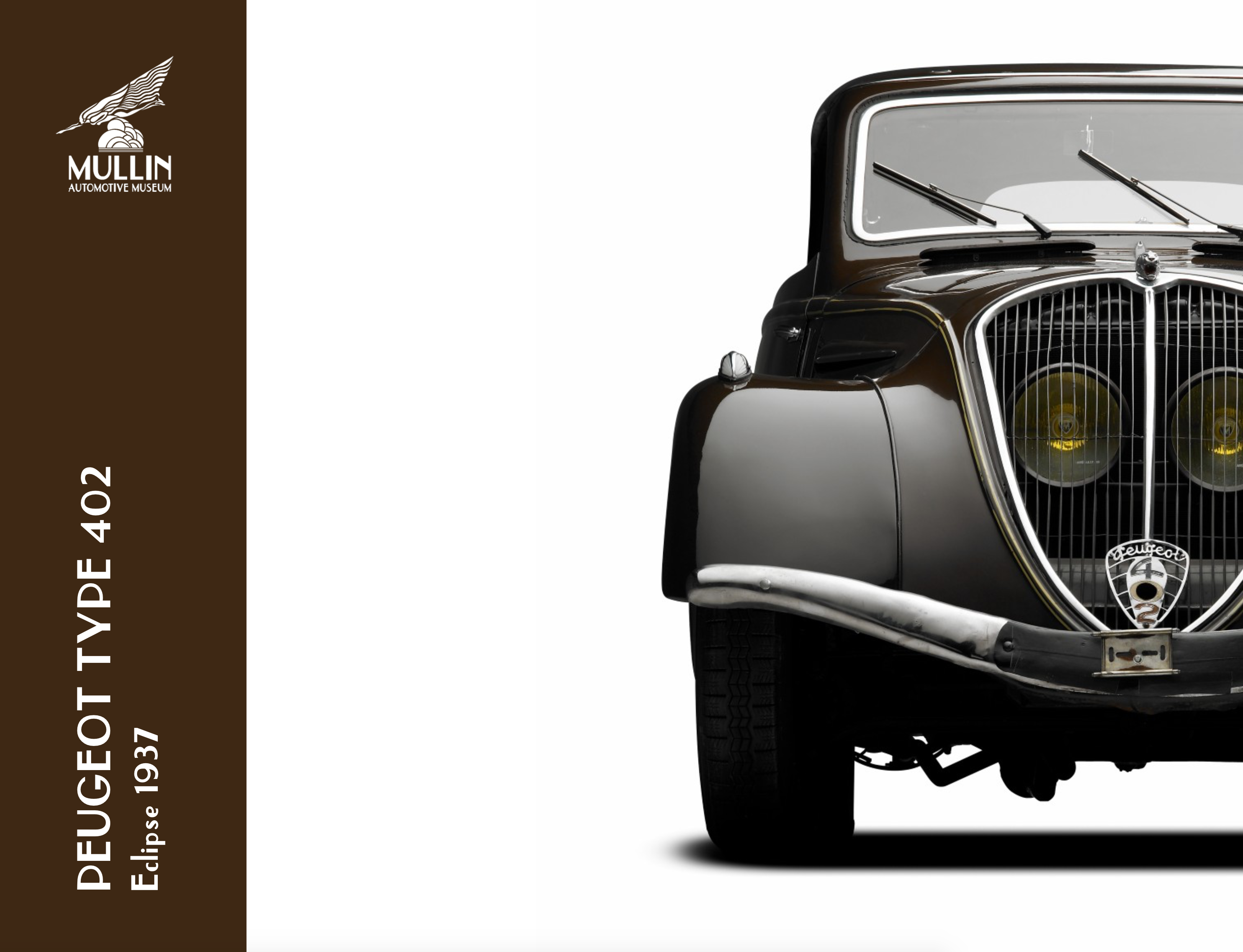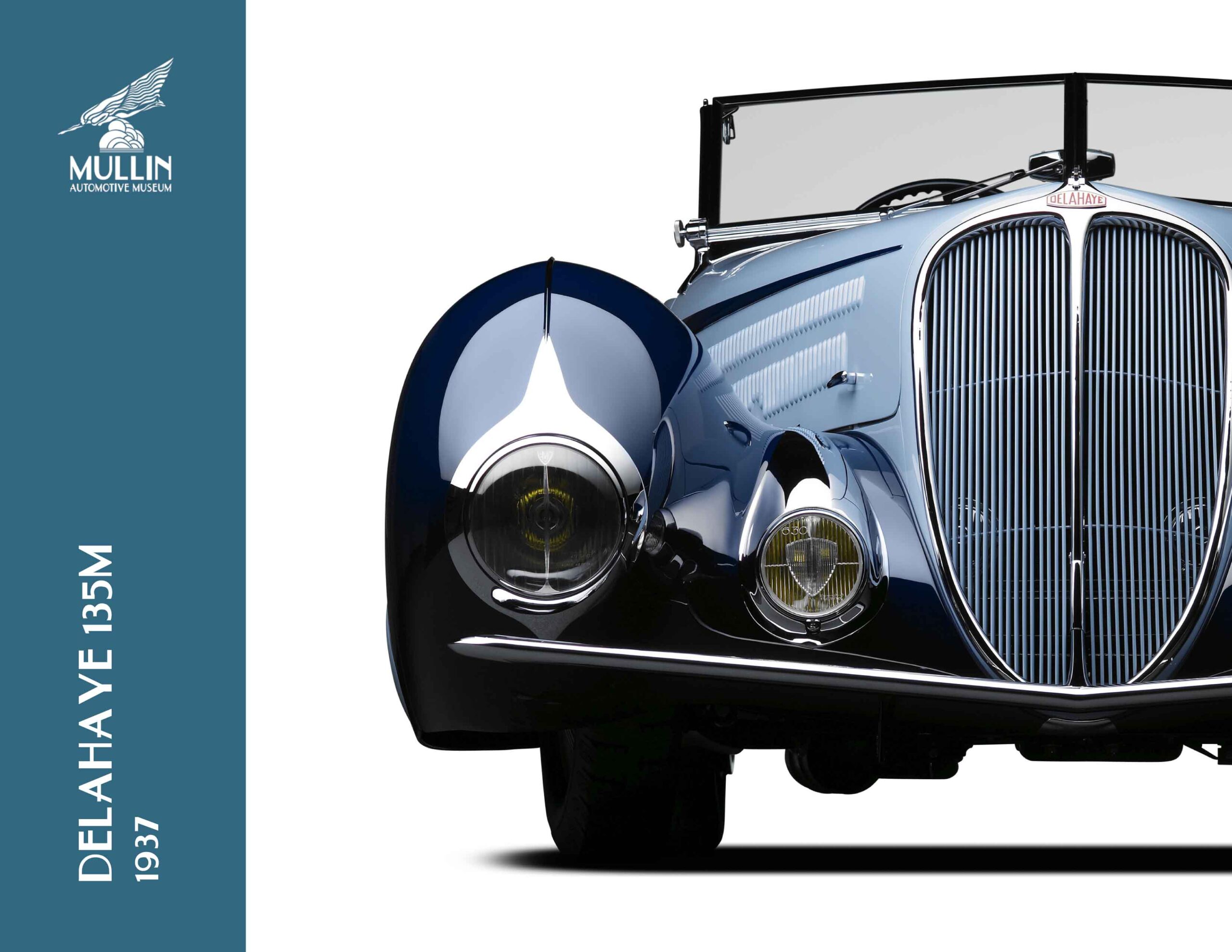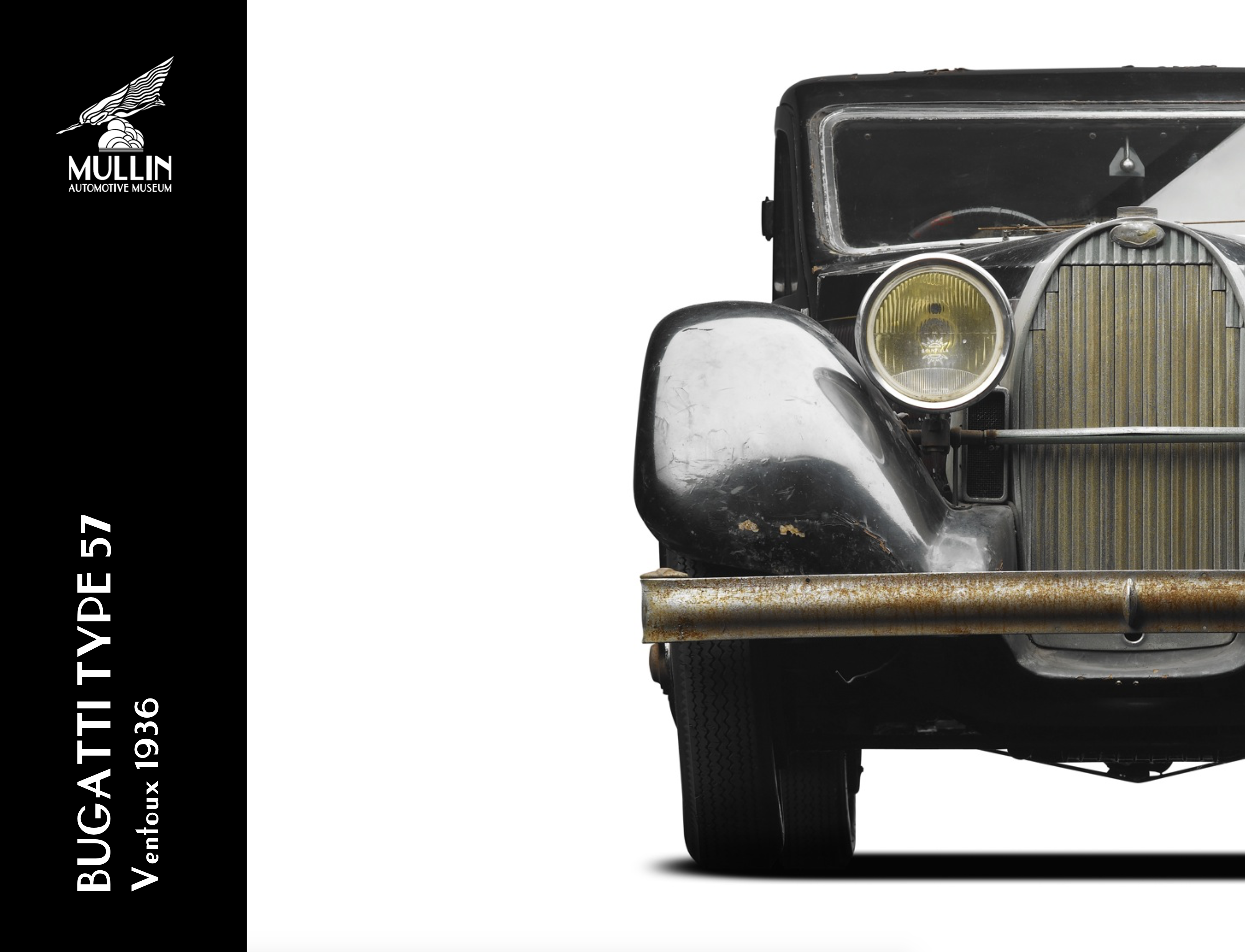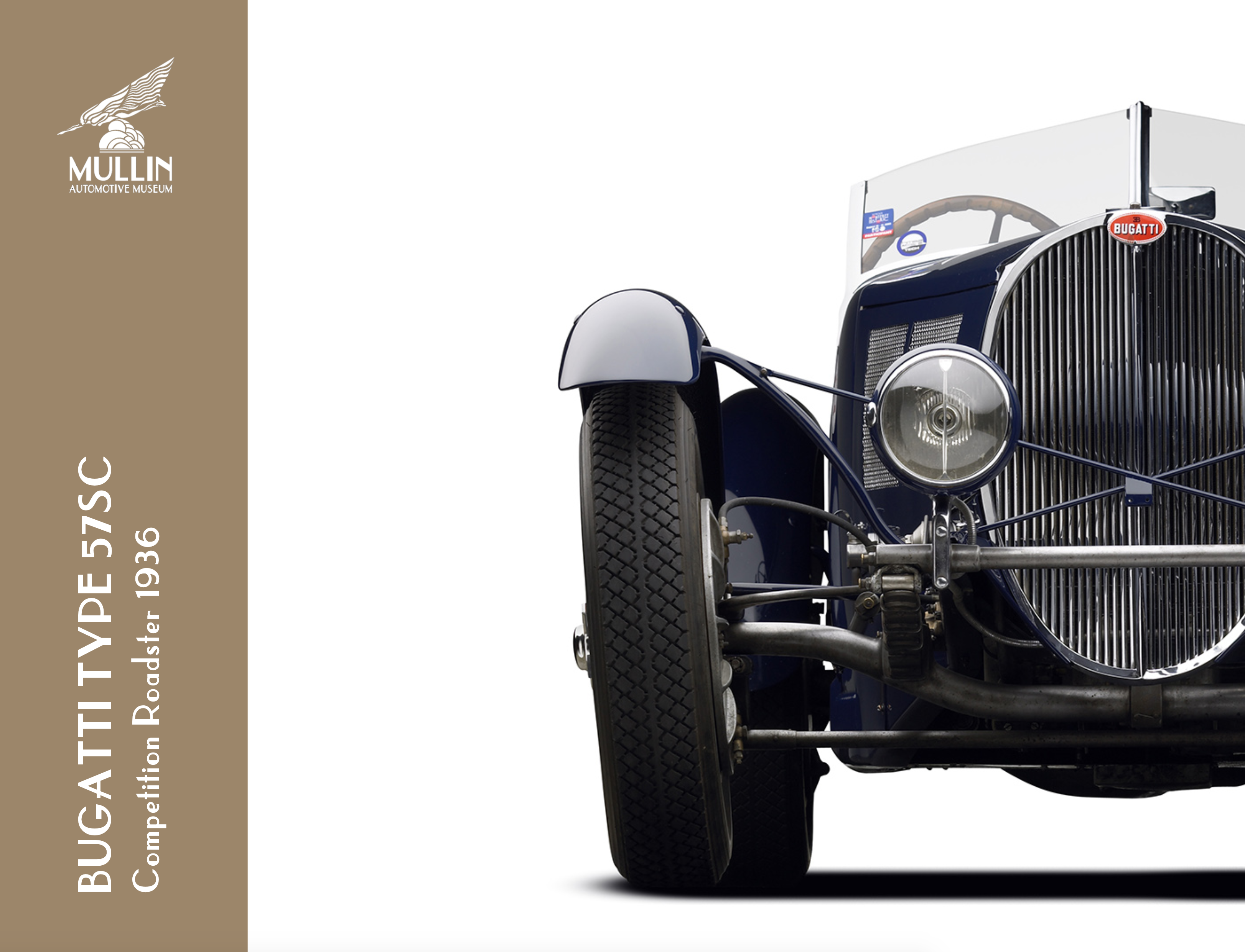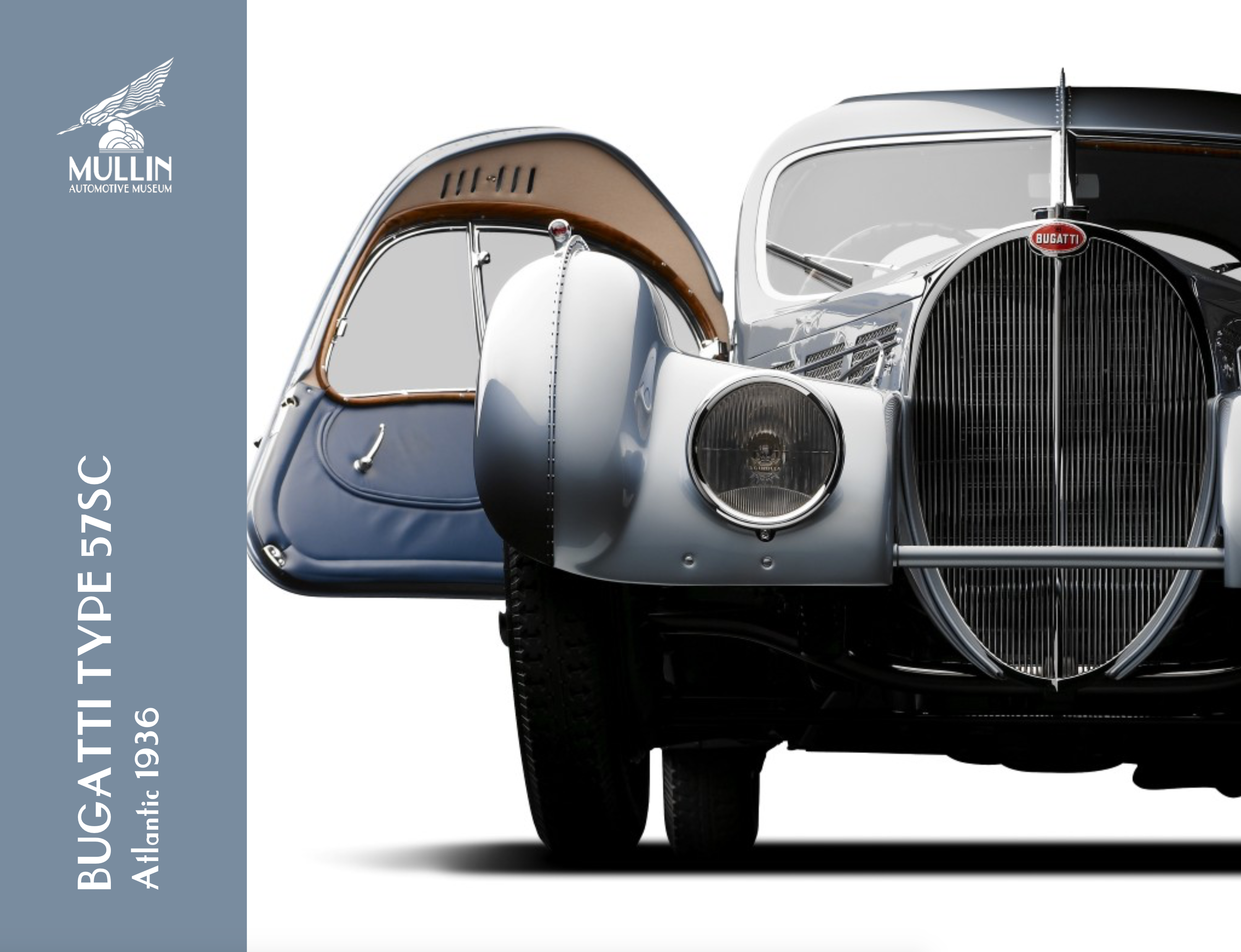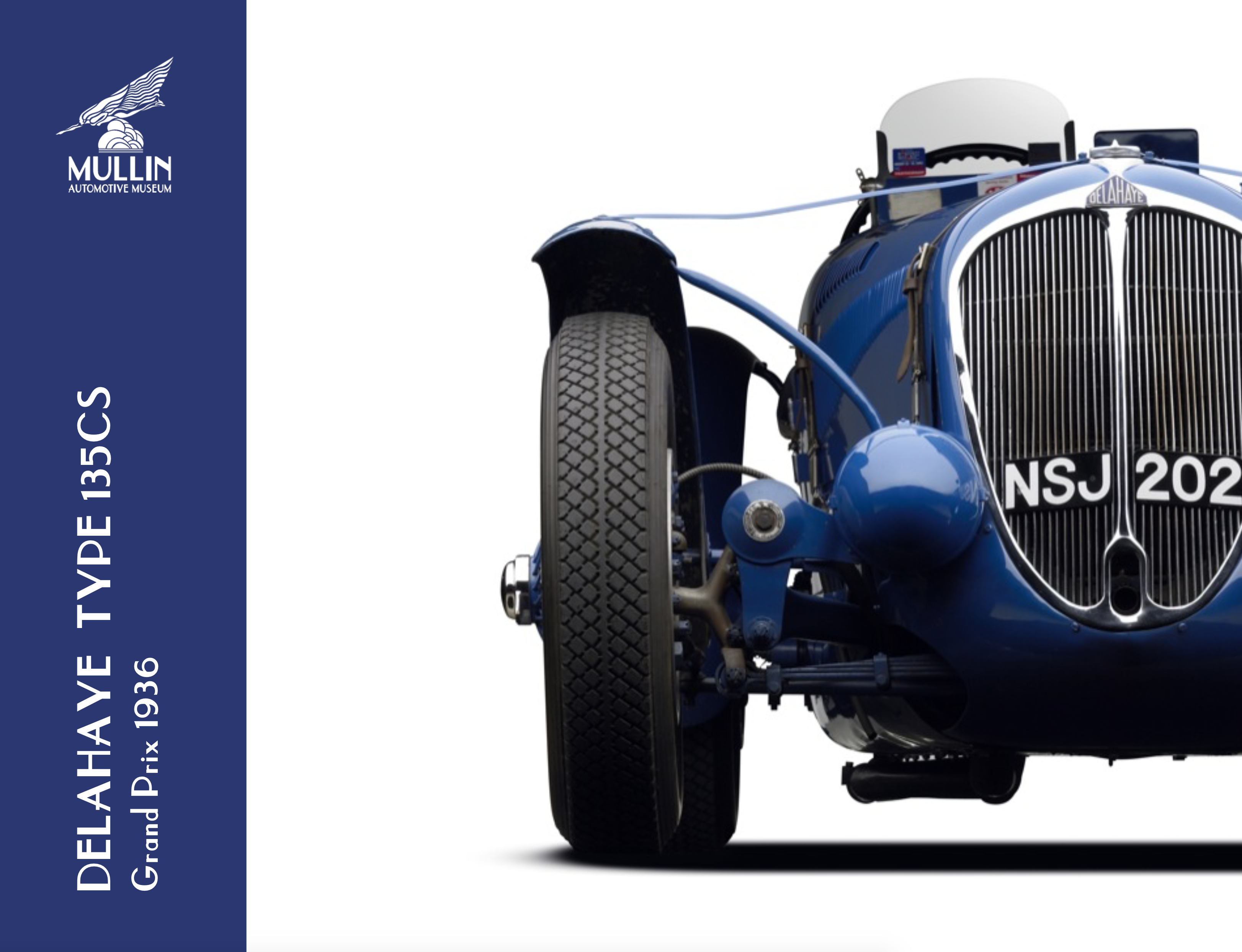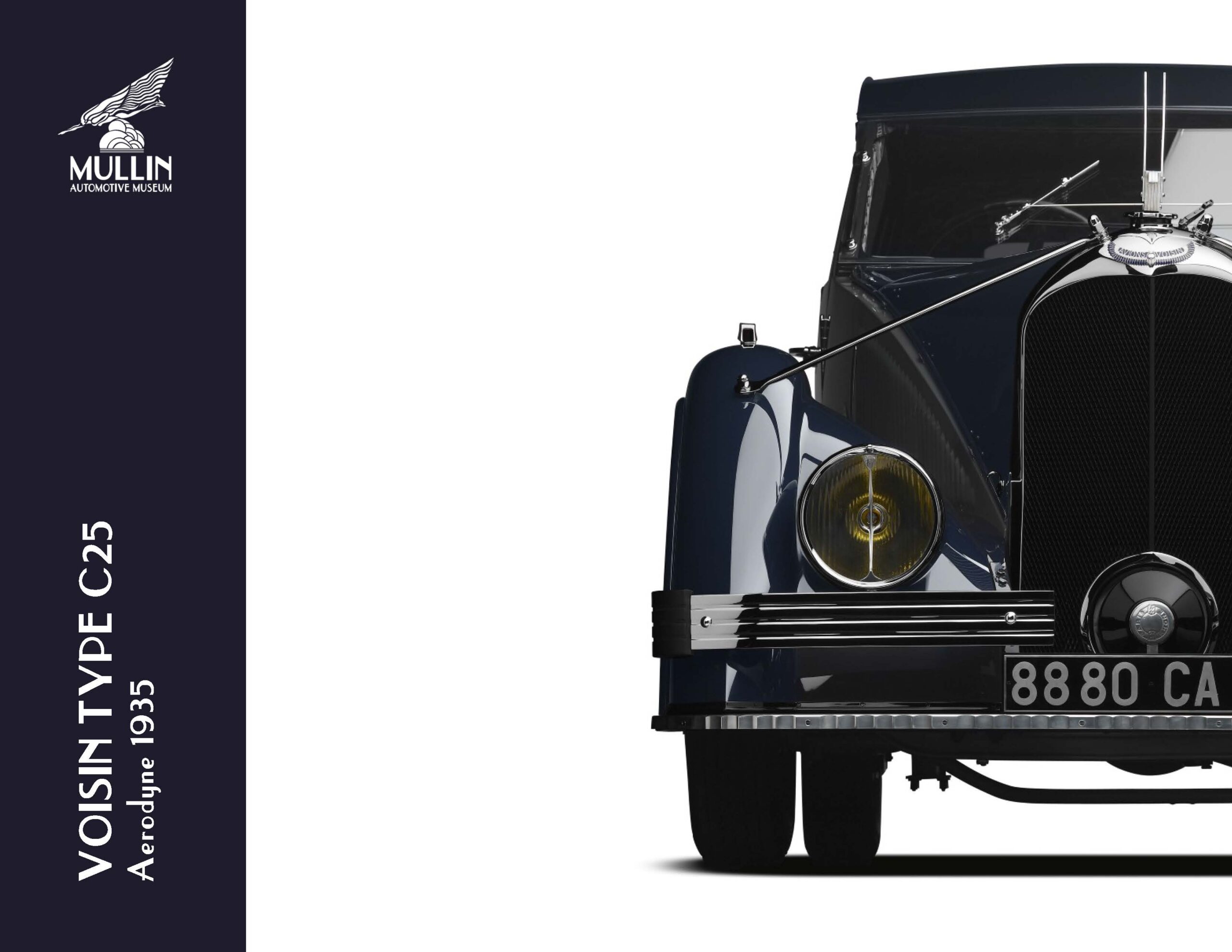Order cars by
Bugatti Type 101C
1951
The Postwar Bugatti
The Postwar Bugatti Whispers of a new Bugatti for the 1951 model year set Bugatti fans astir—the Type 101’s modern style was much anticipated. After Jean Bugatti’s tragic death in 1939, and the death of his father and Bugatti founder, Ettore, in 1947, the youngest Bugatti, Roland, took his place at the head of the firm in an effort to revive the mourning marque. Despite the waning finances and tense nerves of the company’s directors, Roland’s Type 101 was revealed in 1950.
The Type 101’s chassis was essentially a Type 57 with a few new parts that replaced those that had been discontinued during World War II. The Type 101 had a solid front axle, two Weber carburetors, and a Cotal semi-automatic transmission. The engine was made of leftover prewar blocks and parts of the 1939 Type 57Cs. Unfortunately, because of its outdated prewar technology and uncompetitive price, the model was not well received by the public. Additionally, the lack of a European luxury market due to the postwar depression meant that most European cars were produced for export with left-side drive. The Type 101 was right-side drive, and therefore it did not appeal to the booming American market. Very few were sold.
Chassis 101501’s beautiful coachwork was designed by the Gangloff firm. The open coachwork, a two-door, four-passenger cabriolet, encapsulated the skirted pontoon styles that had become so popular in the American market. The resultant car was displayed at the 1950 Paris Auto Salon as a supercharged Type 101C version. Only six Type 101s were ever made.
Chassis 101501 was first sold in 1953 to Mr. P. Rentz, the director of a cheese dairy in Ostheim in the Alsace region of France. The Bugatti went through a succession of nine owners in France, Germany, and the United States, including noted U.S. Bugatti collector Gene Cesari, before Walter Grell of Switzerland purchased it in 1988. Peter Mullin bought the Type 101 in 2010, and it is now part of the Mullin Collection.
| Coachbuilder | Gangloff |
| Chassis number | 101501 |
| Profile type | Touring |
| Body type | Cabriolet |
| Number made | 2nd of 7 |
| Production span | 1951 |
| Front brakes type | Lockheed hydraulic |
| Rear brakes type | Lockheed hydraulic |
| Front suspension type | Solid axle with semielliptical leaf springs and telescopic shocks |
| Rear suspension type | Live axle with reversed quarter-elliptical leaf springs and telescopic shock absorbers |
| Length | 17' 1" |
| Height (Ground line to highest roof) | 5' |
| Width | 5' 3" |
| Wheelbase | 3.3 m |
| Front tracks measurements | 1.35 m |
| Rear tracks measurements | 1.35 m |
| Engine number | 101501 B |
| Type | Inline |
| Number of cylinders | 8 |
| Bore x stroke | 72 mm x 100 mm |
| Displacement | 3257 |
| Distribution | Double-overhead camshaft; superchaged |
| BHP at 5200 RPM | 180 |
| Gearbox | Manual |
| Number of gears | 4 |
| Overdrive | 0 |
Delahaye 235
Roadster, 1951
A Modern Delahaye
“The best of the coach-built era, with a modern twist.” —Peter Mullin The Delahaye 235 was an exclusive sports car that exuded the luxury of prewar handcraftsmanship combined with postwar technological innovation.
Following WWII, economic power shifted to the U.S., where mass production became the new model to serve a growing American market. Only a handful of coachbuilders survived the postwar depression. Those that did designed for American clients that preferred large, “enveloped” bodies. The 235’s fully enveloped fenders and large steering wheel with its chrome rim and central crown insignia were quintessentially American, mimicking styling that could have been found on any Cadillac of the era.
While the Delahaye 235 was marketed as a new model, designed and styled for the postwar market, it was built on a modernized prewar Type 135 MS chassis. It sported a new grille, but retained the old 3.5-liter motor, with minor modifications to the camshaft and carburetors that boosted the horsepower to 150. The Saoutchik styled body was constructed from a unique combination of aluminum (applied to the body from the doors forward) and steel (applied to the rear), providing balance while reducing the car’s weight. When the car made its debut at the 1951 Paris Auto Salon, the public deemed it exquisite, but the price tag—nearly double the Jaguar’s—was too high. The 235 was Delahaye’s last luxury car, and none was more elegant than this example.
Chassis 818005 was owned by a French collector for nearly fifty years and was only stored away when it stopped working in 1964. It was rediscovered in France in 2006 by Jacques “Frenchy” Harguindeguy, an American collector from Walnut Creek, California, who displayed it in its original condition at the 2007 Pebble Beach Concours d’Élégance. Peter Mullin purchased the car in 2007 and subjected it to a comprehensive restoration.
| Coachbuilder | Saoutchik |
| Chassis number | 818005 |
| Profile type | Touring |
| Body type | Roadster cabriolet |
| Number made | 5th of 84 |
| Production span | 1951-1954 |
| Front brakes type | Cable-operated |
| Rear brakes type | Cable-operated |
| Front suspension type | Independent transverse leaf spring with upper control arms and lever action shock absorbers |
| Rear suspension type | Live axle with semi-elliptical leaf springs and lever action shock absorbers |
| Length | 15' 8" |
| Height (Ground line to highest roof) | 4' 8" |
| Width | 5' 10" |
| Engine number | 818005 |
| Type | Inline |
| Number of cylinders | 6 |
| Displacement | 3557 |
| Distribution | Overhead valves |
| BHP at 4200 RPM | 150 |
| Gearbox | Cotal pre-selector |
| Number of gears | 4 |
| Overdrive | 0 |
Talbot-Lago Type 26-GS
1951
Il Design Italiano
The two-seat convertible coupé built by Stabilimenti Farina of Turin won the award for best custom coachwork at the 1951 Paris Auto Salon. This Talbot-Lago T 26-GS is the only known Talbot-Lago Grand Sport to have been bodied by an Italian coachbuilder. The modern design, produced by the Italian Stabilimenti Farina firm, reflected the Americanized style of the era, complete with elongated pontoon body and chrome accents on the custom radiator.
By 1951 the market had become disenchanted with Talbot-Lago’s touring models and focused instead on the Grand Sport—an energetic model first introduced in 1947 based on the marque’s winning grand prix technology. A total of thirty-six cars were produced in the Type 26-GS series, each one a custom order for a wealthy patron. Such chassis were usually the province of Figoni & Falaschi, Jacques Saoutchik, and other French luxury coachbuilders, but the custom body produced for this vehicle is unique.
In 1950 a Portuguese car collector ordered a Grand Sport chassis from the Talbot-Lago factory in Paris. He talked to several coachbuilders in France, but settled on a two-passenger convertible coupé painted bianco latte (milk white) designed by Italy’s Stabilimenti Farina. When the body was finished, the owner insisted that the wooden mockup used to design the car be destroyed so no one else could have a Talbot-Lago like his. In 2006 the car was restored from the ground up, receiving a rich burgundy body that was unveiled at the 2010 Pebble Beach Concours d’Élégance, where it won First in Class.
The owner of this car, Chassis 110160, took it to Portugal following the 1951 Paris Auto Salon. Another car enthusiast, Jacques Touzet, fell in love with it the moment it arrived in Lisbon. Touzet followed the owner around for two years, contacting him repeatedly regarding the vehicle. Persistence eventually paid off when Touzet was able to buy the car in 1953. Touzet thoroughly enjoyed his purchase for the next forty-seven years, but in 2000, he decided he was getting a little too old for his toy. The car was purchased by Charles Morse, who then sold it to Peter Mullin the following year.
| Coachbuilder | Stabilimenti Farina |
| Chassis number | 110160 |
| Body type | Cabriolet |
| Length | 16' |
| Height (Ground line to highest roof) | 4' 10" |
| Width | 6' |
| Type | Inline |
| Number of cylinders | 6 |
| Displacement | 4483 |
| Distribution | Hemispherical head; inclined valves, double-high, side-mounted camshafts |
| Engine capacity & output | unavailable |
| Gearbox | Wilson preselective epicyclical |
| Overdrive | 0 |
Talbot-Lago Type 26GP
1950
The Talbot-Lago Formula
For the 1950 racing season, Anthony Lago formulated a car that launched his iconic Type 26 chassis to the forefront of speed and endurance technology. The end of World War II saw the advent of a new form of competitive racing that tested a machine’s speed and endurance among a class of cars honed to a degree of power beyond that of production models. For the competition’s inaugural year in 1950, Talbot-Lago entered the Type 26 Grand Prix. Its class: Formula One.
The Formula One category was founded in 1948, but did not have its first national competition until 1950. Competitors were challenged to build cars that met one of two regulations: one for supercharged cars with maximum 1.5-liter engines, and one for unsupercharged models with maximum 4.5-liter engines.
Talbot-Lago chose to create a simple, unsupercharged 4.5-liter car on a Type 26 chassis—a chassis touted as the “fastest production chassis in the world,” by Autocar Magazine in October 1948. This car, Chassis 110052, is from the marque’s second series Type 26s, made blazingly fast with the addition of twin ignition plugs that created an additional 50 brake horsepower and top speeds of more than 166 miles per hour. The factory-built body is a sleek bullet with a tapered rear that maximizes aerodynamic efficiency. The bare exhaust pipes are a reminder of this refined machine’s true ambitions–speed and endurance.
Talbot-Lago operated a factory racing team for roughly ten years. Although it was small and its financial resources were limited, it did much to elevate the prestige of French racing and develop the reputation of international Formula racing worldwide.
| Coachbuilder | Factory |
| Chassis number | 110052 |
| Profile type | Grand Prix |
| Body type | Grand Prix |
| Number made | 2nd of 10, second series |
| Production span | 1950-1951 |
| Front brakes type | Lockheed hydraulic |
| Rear brakes type | Lockheed hydraulic |
| Front suspension type | Independent transverse leaf spring with upper control arms, tubular and friction shock absorbers |
| Rear suspension type | Live axle with semielliptical leaf springs, tubular and friction shock absorbers |
| Length | 14' |
| Height (Ground line to highest roof) | 3' 3" |
| Width | 5' 9" |
| Engine number | 45152 |
| Type | Inline |
| Number of cylinders | 6 |
| Displacement | 4482 |
| Distribution | Double-overhead camshaft |
| BHP at 4500 RPM | 250 |
| Gearbox | Wilson pre-selector |
| Number of gears | 4 |
| Overdrive | 0 |
Bugatti Type 57C
Aravis, 1939
A Showmanâs Daily Driver
This Aravis was created for Maurice Trintignant, famous racer of Bugatti’s factory team. A man well-acquainted with the wheel, the Aravis was the one car he regretted selling. Named for a mountain pass in the French Alps, the Aravis is a stunningly realized member of Jean Bugatti’s Type 57 production line. Bugatti himself claimed that Chassis 57768 was “the most beautiful Type 57.”
Bugatti chose the Gangloff firm to construct the coachwork for this Aravis. Gangloff’s refined styling was chosen for many Bugattis not bodied by the Bugatti factory themselves. Gangloff executed the signature Bugatti style with exacting precision. The distinctive Jean Bugatti two-tone paint and decorative beltline finishing were, by this point, a hallmark of the Bugatti design. The profile and dipping shape of the teardrop fenders cascade toward the ground, an effect that entices one to believe the rear axle itself is engaged and launching the vehicle forward—a silhouette built for speed.
For car manufacturers, racing was an essential marketing tool. The Aravis, a two-door, two-seat cabriolet with an additional side-facing child’s seat in the rear, boasts an engine inspired by and created for Grand Prix racer Maurice Trintignant. A racecar driver who used a production model for everyday travel provided an unparalleled endorsement of a marque’s prowess. Thus, Bugatti heralded Trintignant’s ownership. When Peter Mullin acquired the car and decided to return it to its original condition, he was granted the unique opportunity of collaborating with Trintignant to ensure the authenticity of the restoration. After 60 years, his extraordinary memory of the car had not dwindled.
Jean Bugatti created this Type 57C Aravis especially for Maurice Trintignant, a Grand Prix racer on the Bugatti factory team. Trintignant sold the car in 1947 to Jacques Roblin. From him, it passed into the hands of Madeleine Mitton, and in 1964, into the possession of Rudi van Daalen Wetters. In 2002 Peter Mullin purchased it from Wetters. When Mullin chose to restore it to its original mint condition, he was fortunate to be able to consult with Trintignant, whose memory of the car was undiminished by time. The restoration was completed and the car won its first award at the Pebble Beach Concours d’Élégance in 2005.
| Coachbuilder | Gangloff |
| Chassis number | 57768 |
| Profile type | Touring |
| Body type | Cabriolet |
| Number made | 106 |
| Acceleration | 0 |
| Top Speed | 210 |
| Body | Aravis |
| Front brakes type | Hydraulic |
| Rear brakes type | Hydraulic |
| Front suspension type | Solid axle with semielliptical leaf springs and telescopic shocks |
| Rear suspension type | Live axle with reversed quarter-elliptical leaf springs and telescopic shock absorbers |
| Length | 16' 10" |
| Height (Ground line to highest roof) | 4' 10" |
| Width | 5' 3" |
| Engine number | C75 |
| Type | Inline |
| Number of cylinders | 8 |
| Bore x stroke | 72 mm x 100 mm |
| Displacement | 3257 |
| Distribution | Double-overhead camshaft |
| BHP at 5000 RPM | 170 |
| Gearbox | Manual |
| Number of gears | 4 |
| Overdrive | 0 |
Talbot-Lago Type 26-SS
1938
Talbot-Lagoâs Figoni Racer
Jaw dropping luxury coaches were Joseph Figoni’s forte, the streamlined racer built for hugging turns at break neck speed was an exciting challenge—the truest test of aerodynamic forms. Everyone familiar with the world of classic cars knows that vehicles are often transformed at the whim of an owner. It sometimes happens, however, that a car’s metamorphosis is officially decreed by the factory: this one, Chassis 90203, is such a vehicle.
Chassis 90203 began life as Chassis 82930 and was the first in a series of special Talbot-Lago racecars bodied by famed luxury coachbuilder Joseph Figoni in 1936. Figoni styled the car with an open race body like that of a Type 150-C-SS with a short wheelbase chassis. The car was intended for the Talbot-Lago racing team while similarly bodied cars were marketed to private individuals. Although engineer and founder Tony Lago was dissatisfied with Figoni’s first design, the second body was approved, and it appeared with its new styling on the Figoni & Falaschi stand at the 1937 Paris Auto Salon.
Under René Dreyfus’s direction, the chassis was renumbered as 82933 after the factory installed a new 4.5-liter motor (number 45003) in 1938. The following year the factory again updated the chassis number, this time to 90203, to reflect a new model designation of Type 26-SS. For a manufacturer such as Talbot-Lago, chassis number changes were standard procedure when updating models and styles. Chassis 90203 was eventually sold to Luigi Chinetti’s racing team, and it raced at Le Mans in 1939 before being put in storage for the duration of World War II. The original coachwork designed by Figoni was destroyed after the war, and a new body was installed that had a postwar look more in keeping with the automotive styles of the time.
| Coachbuilder | Chappe Brothers |
| Chassis number | 90203 |
| Profile type | Grand Prix |
| Body type | Grand Prix |
| Number made | 750 |
| Acceleration | 0 |
| Top Speed | unavailable |
| Length | 13' 6" |
| Height (Ground line to highest roof) | 3' 11" |
| Width | 5' 7" |
| Engine number | 45003 |
| Type | Inline |
| Number of cylinders | 6 |
| Displacement | 4500 |
| Distribution | Overhead valves |
| BHP at 5000 RPM | 260 |
| Gearbox | Wilson pre-selector |
| Number of gears | 4 |
| Overdrive | 0 |
Delahaye Type 145
Coupé, 1938
The Veteran
A Retired Racer that has grown more beautiful with age In 1937 Lucy Schell, founder of the Ecurie Bleue racing team, ordered four Delahaye Type 145s to compete in the French government’s automotive engineering challenge, the Million Franc Prize. The Mullin Automotive Museum is home to three of these historical cars. Chassis 48773 is one of the three.
The Mullin Chassis 48771, 48772, and 48773 were exotic V-12 racecars built for speed and endurance. The original aluminum coachwork was utilitarian and devoid of anything that would take away from the aerodynamic form needed to reach high speeds. They experienced much success on the track—racing in international grand prix throughout Europe during the 1937–1939 seasons.
With its racing career at an end, Chassis 48772 was bought by coachbuilder Henri Chapron, who transformed it into one of the most beautiful examples of classic French coachwork of the postwar era. Having by necessity been unproductive during World War II, Chapron began to rebody the car as a two-seat coupé in 1947. The long, narrow, and underslung body was ideal for sleek-looking coachwork. The car bore the signature Delahaye radiator with enveloped, teardrop-shaped fenders and an elaborate beltline that dipped with the downslope of the fenders toward the rear. Its priceless and historic twelve-cylinder engine has remained intact.
| Coachbuilder | Chapron |
| Chassis number | 48772 |
| Body type | Coupé |
| Number made | 1 of 4 |
| Acceleration | 0 |
| Top Speed | 120 |
| Front brakes type | Hydraulic; ventilated |
| Rear brakes type | Hydraulic; ventilated |
| Front suspension type | Independent transverse leaf springs with upper control arms and lever-action shock absorbers |
| Rear suspension type | Live axle with semielliptical leaf springs and lever-action shock absorbers |
| Length | 15' 10" |
| Height (Ground line to highest roof) | 4' 7" |
| Width | 6' 1" |
| Number of cylinders | 12 |
| Displacement | 4496 |
| BHP at 4000 RPM | 184 |
| Gearbox | Cotal electromagnetic |
| Number of gears | 4 |
| Overdrive | 0 |
Tatra Type 87
1938
A Modern Movement
Czechoslovakian auto manufacturing in the 1930s took its roots from the Western European school of aerodynamics. Aérodynamisme was a sign of the times. In the 1930s aerodynamics engineers in Western Europe pursued their vision of science-based automotive coachwork. They used wind-tunnel testing and engineering strategies to develop smooth and enveloped coachwork that cut through the wind. Innovative round bodies, such as that of the Tatra Type 87, set the precedent for modernized coachwork that was popular throughout the 1930s.
The former Czechoslovakian (now Czech Republic) manufacturer Tatra was a leading proponent of the aerodynamics movement and developed the sleek Type 77 in 1933 and the shapely Type 87 in 1938. Tatra’s head engineer, Hans Ledwinka, designed the Type 77’s enveloped profile, with its rounded edges and a protruding rear fin. The streamlined body was attached to a well-balanced, center-beamed chassis with a rear-positioned engine like that of a Volkswagen or Porsche.
The Tatra Type 87 is considerably shorter than the Type 77; however, it is much shapelier, displaying more rounded forms and finely integrated fenders.
The Mullin Automotive Museum acquired the Tatra Type 87 in 2007.
| Coachbuilder | Factory |
| Chassis number | 46089 |
| Body type | Sedan |
| Acceleration | 0 |
| Top Speed | 100 |
| Length | 15' 8" |
| Height (Ground line to highest roof) | 4' 10" |
| Width | 5' 5" |
| Number of cylinders | 8 |
| Engine position | Rear |
| Displacement | 2965 |
| Distribution | Overhead camshaft |
| Engine capacity & output | unavailable |
| Gearbox | Manual |
| Overdrive | 0 |
Voisin Type C30
Goëlette Cabriolet, 1938
The Rule Breaker
In a tumultuous time of administrative change, the Type C30 revealed Gabriel Voisin’s dedication to his marque’s engineering principles and expert styling. The Voisin Type C30 was developed and launched by Gnome et Rho?ne administrators who assumed control of the Voisin marque in 1937 and not under Gabriel Voisin’s sole influence; it had neither engine nor coachwork bearing the “Voisin” signature. Yet, in its own way the Voisin Type C30 was just as revolutionary as the marque’s other models.
The Type C30 made its debut at the 1937 Paris Auto Salon when Voisin was no longer the head of his company and the majority of Voisin cars were produced from used and spare parts. The assembled car was intended to maintain many traditional Voisin features, such as a long wheelbase and overall simplicity, but it departed from the material refinement generally demanded by Gabriel Voisin’s exacting vision. As for engines, lack of funding forced Voisin to cease manufacturing his typical sleeve-valve power plants. Instead, he relied on an American supercharged Graham-Paige model—a popular engine known for its quiet operation and therefore more aligned with Voisin’s tastes.
For a marque known for factory bodied cars, Chassis 60007 further bent the rules with coachwork built by an outside coachbuilder, Louis Dubos. This small firm had operated since the 1920s, when it made a name for itself with rigid, soundproof bodies that relied on a supple connection between coachwork and chassis. Stylistically, the Voisin Type C30 Goëlette is the elegantly proportioned product of classical workmanship. On its conservative ensemble, only the grille—a shock of chrome reminiscent of the modern American style and bearing an alternative style hood ornament—surprised the public. The two-door cabriolet in the Mullin Collection is very rare; one of the last Type C30s built in the series, appreciated for its unique coachwork and place in Voisin history.
| Coachbuilder | Louis Dubos |
| Chassis number | 60007 |
| Profile type | Touring |
| Body type | Cabriolet |
| Number made | 30 |
| Acceleration | 0 |
| Top Speed | unavailable |
| Front brakes type | Hydraulic |
| Rear brakes type | Hydraulic |
| Front suspension type | Solid axle with semielliptical leaf springs and friction shock absorbers |
| Rear suspension type | Live axle with semielliptical leaf springs and friction shock absorbers |
| Length | 16' 2" |
| Height (Ground line to highest roof) | 4' 9" |
| Width | 5' 10" |
| Type | L-head; Graham-Paige engine |
| Number of cylinders | 6 |
| Displacement | 3560 |
| Distribution | Supercharged |
| BHP at 4000 RPM | 116 |
| Gearbox | Manual |
| Number of gears | 3 |
| Overdrive | 0 |
Auto Union W25K Roadster
Wanderer, 1937
A Car with a Soul
According to Peter Mullin, the Wanderer will never be restored. Its story is preserved in its seats, its headliner, and its fellow cars from the Schlumpf Reserve Collection. The Auto Union Wanderer came to the Mullin Automotive Museum as part of the Schlumpf Reserve Collection— a group of 62 unrestored cars previously owned by textile giant Fritz Schlumpf.
In 1977 the French government seized Schlumpf’s collection of some 500 cars after a crash in the textile business forced him into bankruptcy. The ensuing legal battle lasted for 20 years until the Reserve Collection was released to Schlumpf’s widow Arlette in 1999. Arlette kept them hidden away in a barn in Malmerspach where few were granted entrance to see the treasure trove. Mr. Mullin had known Arlette and was given the promise of the first call when the lot came up for sale. When Mr. Mullin received the call in 2008 he was at the barn in moments. What he found inside was a dream: row upon row of Bugattis, Delahayes, Hispano-Suizas and Peugeots, the list goes on. After some soul searching of his own, Mr. Mullin purchased the collection, only retaining cars of particular historical significance and selling the rest. The Wanderer is one of these cars.
The Wanderer is one of only three cars in the Mullin Collection not of French heritage. A German car, it was Dr. Ferdinand Porsche’s first project after he graduated from engineering school in 1930. Porsche was a consultant to several German carmakers, and he worked with the Wanderer automotive company on the design and manufacture of the W25K’s supercharged engine. The W25K was the product of four German automobile companies—Audi, DKW, Horch, and Wanderer—who merged in 1932 to form Auto Union. The four interlocking rings of Auto Union’s badge are seen on modern Audis to this day.
Little is known of the Wanderer’s early history. Fritz Schlumpf purchased it in 1964, and it was confiscated by the French government in 1977. Part of the Schlumpf Reserve Collection, it was released to Fritz Schlumpf’s widow, Arlette, in 1999. She chose not to restore the cars, but left them where and as she found them. After she died in 2008 the collection once again became available to collectors. Car dealers Bruno Vendiesse and Jaap Braam Ruben purchased the collection, which they soon sold to Peter Mullin. He kept approximately half of the Schlumpf Reserve Collection to display in the Mullin Automotive Museum.
| Coachbuilder | Factory |
| Chassis number | 180223 |
| Profile type | Touring |
| Body type | Roadster cabriolet |
| Number made | 257 |
| Production span | 1936-1938 |
| Acceleration | 0 |
| Top Speed | 93 |
| Front brakes type | Lockheed hydraulic |
| Rear brakes type | Lockheed hydraulic |
| Front suspension type | Independent suspension with transverse leaf springs |
| Rear suspension type | Rigid Axle with independent suspension and transverse leaf springs |
| Length | 12' 8" |
| Height (Ground line to highest roof) | 4' 10" |
| Width | 5' 7" |
| Weight | 2200 lbs |
| Engine number | 180231 |
| Type | Inline |
| Number of cylinders | 6 |
| Engine construction | Aluminum |
| Displacement | 1963 |
| BHP at 4000 RPM | 85 |
| Gearbox | Manual Syncromesh |
| Number of gears | 4 |
| Overdrive | 0 |
Delage D8-120
1937
The Mistress
Remarkably tuned and known for its exceptional handling, —the 8-cylinder D8-120 was easily maintained and effortlessly driven. Early twentieth century car connoisseur David Scott-Moncrieff once opined: “One drives an Alfa, one is driven in a Rolls, and one buys the girlfriend a Delage.” His remark reflects the era in which the Delage D8-120 was introduced—when there was a tantalizing sexiness to luxury cars that made them seem almost illicit. Indeed, the Delage was driven by sportswomen with high quality taste, but beneath its bonnet, the D8-120’s V-8 engine—forged from Louis Delage’s experience on the track—also caught the attention of road-savvy gentlemen with an eye for style.
Compared with other leading marques of the time, Delage stood out as a provider of exceptionally smooth, easy-to-handle, and potent automobiles. The D8-120s winning combination of power and effortless control was well received by Delage clientele who wanted a luxury option less physically demanding than the hefty steering provided by other marques. Unfortunately, the economic situation made it difficult to sell the sturdy chassis, and the company’s assets were soon sold to the Delahaye firm.
The D8-120’s elongated form presented coachbuilders with a new opportunity to explore exaggerated vehicle architecture. The result was some of the most elegant, refined, and classic coachwork of the era. Chassis 51760 was delivered by classic French coachbuilder Henri Chapron as a four-seat cabriolet with a three-position top. It was from the model’s second series and thus had a lower, lighter chassis than its predecessor. The beautiful cabriolet made it to the big screen in the 1951 classic An American in Paris starring Gene Kelly and Nina Foch. The car was given a makeover for the film that included taillight modifications and a new green paint job—Chapron himself was involved in the alterations. In the film Gene Kelly is chauffeured around the City of Light in the Delage with Nina Foch. The car was returned to its current color after Peter Mullin purchased it in 1987.
Chassis 51760’s early history was colorful, as it was reportedly appropriated by a French general of the Vichy government who was a German collaborator. In 1946, after the war’s end, the general sent the car to California but was unable to obtain a visa for himself, so he went to Argentina and sold the car to RKO Studios. In Hollywood the car’s graceful and conservative styling earned it a role in the 1951 classic An American in Paris. The film’s producers commissioned certain changes to the car’s design, including taillight modifications and a new green paint job. The car’s original French coachbuilder, Henri Chapron, was involved in the alterations.
When the movie was completed, the car returned to Los Angeles, where it was acquired in 1955 by Thol “Si” Simonson, a member of the RKO Studios production team. He took the car in lieu of the $15,000 in severance pay he was owed by RKO. Simonson drove the Delage around California before putting it up for auction in 1987, at which time Peter Mullin bought the car. The D8-120 is now owned by the Mullin Automotive Museum.
| Coachbuilder | Chapron |
| Chassis number | 51760 |
| Profile type | Touring |
| Body type | Cabriolet |
| Number made | 66 |
| Acceleration | 0 |
| Top Speed | 175 |
| Front brakes type | Hydraulic |
| Rear brakes type | Hydraulic |
| Front suspension type | Independent transverse leaf-spring with upper control arms and lever-action shock absorbers |
| Rear suspension type | Live axle with semielliptical leaf springs and lever-action shock absorbers |
| Length | 17' 8" |
| Height (Ground line to highest roof) | 5' 1" |
| Width | 5' 6" |
| Engine number | 51760 |
| Type | Inline |
| Number of cylinders | 8 |
| Displacement | 4500 |
| Distribution | Overhead camshaft |
| BHP at 4000 RPM | 115 |
| Gearbox | Cotal pre-selector |
| Number of gears | 4 |
| Overdrive | 0 |
Delahaye Type 145
1937
The Million Franc Challenge
In 1937 Lucy Schell, founder of the Écurie Bleue racing team, ordered four Delahaye Type 145s to compete in the French government’s automotive engineering challenge, the Million Franc Prize. After months of tuning, legendary driver René Dreyfus drove 200 kilometers in one of Lucy Schell’s Type 145s for a record one hour, twenty-one minutes, 49 1/2 seconds at an average speed of 91.3 miles per hour. The Million had been won.
The story of the Million Franc Prize begins with the charged atmosphere of pre–World War II Europe. In the years leading up to the war, when Germany and Italy were ramping up their military forces, sporting events were seen as metaphorical struggles between democracy and the totalitarian powers. When the Automobile Club of France changed its formula for the 1937 racing season—dictating that engines could be as large as 4.5 liters, unsupercharged—the French government saw its chance to pull ahead in the technology race. A challenge was organized: one million French francs would be awarded to the first car to break the 200 kilometer distance record set in 1934 by Louis Chiron in an Alfa Romeo.
Delahaye’s finished car was exotic and strictly utilitarian, fitted with all-metal-alloy coachwork that tightly sheathed the chassis. The engineers at the factory never tested it in a wind tunnel and relied instead on their experience and intuition, the power of the Type 145’s unsupercharged 4.5-liter, V-12 magnesium engine, and the aerodynamic properties of the low-slung and well-balanced chassis.
The car was returned to the factory before World War II. It was hidden during the war to protect its precious magnesium engine, which was eventually sold, separate from the chassis, to a mechanical school as a demonstration model. The chassis was rebodied, and its grand history forgotten, until Peter Mullin recognized and purchased it in 1987. With the aid of automotive historians and restorers, Mullin located the car’s original magnesium engine and restored the complete car to its original condition.
This is one of four racecars built for the Écurie Bleue racing team founded by the Americans Laury and Lucy Schell. Just before World War II hostilities began, Lucy Schell sent all her Delahaye racecars back to the factory. Delahaye carefully kept this car hidden to protect its magnesium engine from destruction. In 1947, after the war was over, the engine and transmission were donated to André St. Blancard, the director of the Lycée Pilote de Montgeron. a mechanical trade school.
In 1948 the car, without its magnesium engine, was acquired by Charles Pozzi, entrepreneur and French driver of the Écurie Lutétia. Since the chassis had no engine, Delahaye lent Pozzi its new Type 175S engine. In 1950 Pozzi returned the engine to the factory, added a Ford Comète body to the racing chassis, and replaced the V12 engine with a 3.5-liter, six-cylinder Type 135S engine. After the 1951 season Pozzi asked Delahaye sales manager Jean-Pierre Bernard (who later founded the Delahaye Club) to sell the car. Bernard eventually sold it to the collector Serge Pozzoli, who discarded the Ford Comète body and Type 135S engine and replaced the latter with the Type 155 V12 magnesium engine and transmission that had been given to St. Blancard. However, Pozzoli and Bernard were unaware that this was the original magnesium engine, believing it to be a Type 145. Pozzoli stored the Delahaye under the stands at the Montlhéry racetrack until moving it to his château du Gérier near Evreux, France.
Peter Mullin purchased the car in 1987 and sent it to England for restoration by Crosthwaite and Gardiner, where the engine was rebuilt and the original racing body re-created. In 2006 Jim Stranberg of High Mountain Classics reviewed the drawings for the Type 145, 155, and 165 engines and determined that Chassis 48771’s engine was the original magnesium engine, not a Type 145, as previously believed. The complete, and original, Chassis 48771 is now owned by the Mullin Automotive Museum.
| Coachbuilder | Factory |
| Chassis number | 48771 |
| Profile type | Grand Prix |
| Number made | 1 of 4 |
| Acceleration | 0 |
| Top Speed | 165 |
| Front brakes type | Hydraulic; ventilated |
| Rear brakes type | Hydraulic; ventilated |
| Front suspension type | Independent transverse leaf springs with upper control arms and lever-action shock absorbers |
| Rear suspension type | Live axle with semielliptical leaf springs and lever-action shock absorbers |
| Length | 14' 9" |
| Width | 5' 7" |
| Engine number | 155 |
| Number of cylinders | 12 |
| Engine construction | Magnesium |
| Displacement | 4496 |
| BHP at 5500 RPM | 225 |
| Gearbox | Manual |
| Number of gears | 4 |
| Overdrive | 0 |
Hispano-Suiza Type K6
Break de Chasse, 1937
Break de Chasse
This Break de Chasse coach was the only wood-paneled car produced on a Hispano-Suiza chassis. The Franay firm created the exceptional coachwork of this Break de Chasse (Shooting Brake) in 1948. The name derives from vehicles with heavy chassis that were used to break in strong-willed horses; eventually it came to refer to the body style of vehicles used by shooting parties to carry equipment and game. Having owned the Type K6 since 1937, manufacturing scion Maurice Solvay desired a change, and he commissioned more practical coachwork.
In 1934 Hispano-Suiza introduced the Type K6 to accompany the twelve-cylinder Type J12, which had become prohibitively expensive in the struggling French economy. The modest Type K6 was equipped with a six-cylinder, 5.184-liter engine. Hispano-Suiza produced 204 Type K6 chassis; of those, about 90 had coachwork by Carrosserie Vanvooren. The Franay coachwork on the Mullin Type K6 is one of a kind.
Franay coaches were distinguished by their elegance and luxury, which rapidly earned the company the opportunity to work for the most prestigious marques. Throughout the 1930s, despite the economic climate, Franay continued to cater to high-end clientele, but after World War II, like many other firms, it fell victim to excesses of ornamentation. Surprisingly, this Break de Chasse was spared because of its wooden coachwork, which did not lend itself to chrome. Over the years the simple coachwork has been preserved and admired by those who recognize its special place in the history of automotive coachbuilding.
The Hispano-Suiza Type K6 Break de Chasse, Chassis 15121, was originally delivered to Maurice Solvay as a six-passenger cabriolet sedan on January 13, 1937. In 1948 Solvay sent the car to the Franay coachwork firm to be rebodied as a Break de Chasse. It was the only “shooting brake” coach built on a Hispano-Suiza chassis.
The car changed hands numerous times. It was successively owned by a Mr. Garino, a Mr. Bolloré, Paul Sac, Philippe Charbonneaux, and Modeste Tréhin, president of the Hispano-Suiza club. During the 1980s the Break de Chasse was restored at a shop in Paris. The Mullin Collection acquired the car in 2002 and completed a comprehensive re-restoration.
| Coachbuilder | Franay |
| Chassis number | 15121 |
| Number made | 204 |
| Acceleration | 0 |
| Top Speed | unavailable |
| Front brakes type | Cable-operated |
| Rear brakes type | Cable-operated |
| Front suspension type | Solid axle with semielliptical leaf springs and friction shock absorbers |
| Rear suspension type | Live axle with quarter-elliptical leaf springs and friction shock absorbers |
| Length | 18' 1" |
| Height (Ground line to highest roof) | 6' 3" |
| Width | 6' 5" |
| Wheelbase | 13' 8' |
| Engine number | 333187 |
| Type | Inline |
| Number of cylinders | 6 |
| Displacement | 5184 |
| Distribution | Overhead valves |
| Engine capacity & output | unavailable |
| Gearbox | Manual |
| Number of gears | 3 |
| Overdrive | 0 |
Peugeot Type 402
Eclipse, 1937
An Electric Cabriolet
Introduced at the 1935 Paris Auto Salon, the Peugeot Type 402 cabriolet featured Georges Paulin’s revolutionary Eclipse convertible system. In 1932 Georges Paulin patented an articulated roof panel that slid backward and disappeared into the trunk, whose lid opened like an oyster to conceal the roof. Quick, simple and easily operated by a single person—Paulin’s roof was a pioneering design in the realm of cabriolet engineering.
Paulin christened the system the Eclipse and tested it on a number of chassis, including a Peugeot Type 301 bodied by coachbuilder Marcel Pourtout. The system was an instant success. Peugeot eventually signed a royalty contract with Paulin and introduced its Type 402 in 1935 based on his concept—slightly upgraded with the addition of an electric motor to power the Eclipse system. Later the motor was removed; apparently, manual operation was less complex and more reliable.
The first one hundred models of the Type 402 Eclipse were hand built by master coachbuilder Marcel Pourtout according to Paulin’s design. Later more affordable models (including the Mullin Eclipse) were built by the Peugeot assembly line to meet customer demand. The car had a rounded radiator grill that housed two headlamps. This design was then applied to other, more compact Peugeot models—first to the Type 302 in 1936 and then to the smaller Type 202 in 1938. Under its resolutely modern exterior, influenced by the aerodynamic Chrysler Airflow exhibited at the Chicago World’s Fair in 1933, the Type 402 features a very classic frame. While many self-supporting unibody coachwork designs were produced at the time, the 402’s body was still separate from the chassis, a distinct structure built of side rails and crossbeams.
Peter Mullin purchased this exceptionally rare and original car in March 2007 from Christoph Grohe in Switzerland. Its earlier provenance is unknown.
| Coachbuilder | Factory |
| Chassis number | 616787 |
| Profile type | Touring |
| Body type | Cabriolet |
| Number made | 500 |
| Acceleration | 0 |
| Top Speed | unavailable |
| Front brakes type | Cable-operated |
| Rear brakes type | Cable-operated |
| Front suspension type | Independent suspension with lower links, transverse leaf springs, and hydraulic dampers |
| Rear suspension type | Live axle with links, cantilever semielliptical leaf springs, and friction shock absorbers |
| Length | 16' 10" |
| Height (Ground line to highest roof) | 5' |
| Width | 5' 8" |
| Engine number | 333787 |
| Type | Inline |
| Number of cylinders | 4 |
| Displacement | 1991 |
| Distribution | Overhead camshaft |
| BHP at 4000 RPM | 55 |
| Gearbox | Manual |
| Number of gears | 3 |
| Overdrive | 0 |
Delahaye 135M
1937
The Star of India
Renowned coachbuilder Joseph Figoni first sculpted the streamlined lines and arcs known as “the French curve” and “the double curve” on the Delahaye Type 135. For today’s automotive enthusiast, the name Delahaye conjures images of the low, sweeping chassis that were the epitome of the streamlined designs fueling the Art Deco movement.
This Delahaye is one of three surviving vehicles that bear the fluid Figoni body shapes that drew raves during the 1936 Paris Auto Salon. The curved arcs of the fenders established the standard for the “French curves” that are considered a signature characteristic of streamlined automobiles from the 1930s. Indicative of the Art Deco movement’s fascination with the machine and flight, Figoni’s designs were inspired by aviation, particularly by René Couzinet’s Arc-en-Ciel (“Rainbow”) plane. The shape of the pontoon covers on the landing gear of Couzinet’s plane are distinctly mirrored in the Type 135’s voluptuous fenders.
This Type 135M, chassis 49150, is known to some as The Star of India. It was commissioned by explorer and businessman Casimir Jourde, a personal friend of Figoni’s and devotee of streamline styling. Jourde owned several Figoni vehicles that he had shipped to India for use during his long travels. In 1939 chassis 49150 was shipped to Bombay (present-day Mumbai), where it caused quite a stir and was eventually sold to Prince de Berae Mukarran Jah. It was rediscovered in 1982 sitting on wooden blocks in a garden shed in Jodhpur. After a complete restoration, The Star of India has returned to its former grandeur and remains one of the shining centerpieces of the Mullin Automotive Collection.
Casimir Jourde ordered this Delahaye in 1937. Painted red, it was one of eleven cars built for Figoni et Falaschi’s Paris Auto Salon between 1936 and 1939. In 1939 the car was shipped to Bombay (present-day Mumbai), where Jourde had business interests. Prince de Berae Mukarran Jah purchased Jourde’s Delahaye and added it to his collection. Years later the car was sold to an unknown buyer and dissapeared. When it was rediscovered in 1982, it was sitting on wooden blocks in a garden shed in Jodhpur. An English dealer bought it in the mid-1980s, disassembled it, and shipped it in crates to England, where it underwent a complete restoration. The original front-end coachwork had been changed in India, where—according to Claude Figoni, son of Joseph Figoni and curator of the Figoni Archives—the flush-mounted headlights were removed and replaced with externally mounted Marchal lights. Because the English dealer did not realize that alterations had been made, the car was mistakenly restored as found. The interior was also redone with the help of vintage photographs supplied by the Figoni Archives. Peter Mullin purchased the car after it competed in the 1992 Pebble Beach Concours d’Élégance and returned to its original configuration, with recessed headlights and properly faired-in taillights. This automobile is now owned by the Mullin Automotive Museum.
| Coachbuilder | Figoni and Falaschi |
| Chassis number | 49150 |
| Profile type | Touring |
| Body type | Cabriolet |
| Number made | 9th of 11 |
| Production span | 1936-1939 |
| Acceleration | 0 |
| Top Speed | 175 |
| Front brakes type | Cable-operated |
| Rear brakes type | Cable-operated |
| Front suspension type | Independent transverse leaf spring with upper control arms and lever action shock absorbers. |
| Rear suspension type | Live axle with semi-elliptical leaf springs and lever action shock absorbers |
| Length | 16' 5" |
| Height (Ground line to highest roof) | 4' 4" |
| Wheelbase | 10' 6" |
| Engine number | 49150 |
| Type | Inline |
| Number of cylinders | 6 |
| Displacement | 3557 |
| Distribution | Overhead valves |
| BHP at 4000 RPM | 130 |
| Gearbox | Cotal pre-selector |
| Number of gears | 4 |
| Overdrive | 0 |
Bugatti Type 57
Ventoux, 1936
The Ventoux Vogue
Jean Bugatti fully embodied the Bugatti family’s artful ways. His instinct for trend-setting style was fully realized in the six designs he created for the Type 57. The Type 57 was one of the truly great Bugatti models—and the most prolific. During its six years of production, seven hundred Type 57 and 57S chassis were built in six different touring model styles: Aravis, Atalante, Atlantic, Galibier, Stelvio and Ventoux.
Chassis 57377 came to the Mullin Automotive Museum as part of the Schlumpf Reserve Collection—a Jean Bugatti initially designed the styles, although individual coachbuilders later added their unique touches. Chassis 57377’s style, Ventoux, was named for Mont Ventoux, the barren peak that dominates the horizon of Provence, France. It was produced as a two-door, four-seat coupé, with the option of either one or two side windows. In the second series of Ventoux bodies, some had trunks that were integrated into the cabin design, giving the model an uninterrupted flow from hood to trunk.
Group of sixty-two unrestored cars previously owned by French textile giant Fritz Schlumpf. Among these cars were a remarkable group of Type 57 Ventoux and Galibiers. The addition of Ventoux and Galibier styles to the Mullin Museum’s collection of Aravis, Atalante, Atlantic, and Grand Prix Type 57 models has made the museum one of the few institutions to possess such a wide array of Type 57 body styles.
Chassis 57377 was delivered to its first owner, Mr. D. Saint, on February 28, 1936, most likely in exchange for another car. Almost no other details of the car’s early history are known. The only clue is that at some point, the initials K. W. were written on the car’s doors, but no documentation of this owner exists. Subsequently, the Type 57 was purchased by American collector John Shakespeare, who sold it to French textile magnate Fritz Schlumpf in 1964. The French government confiscated Schlumpf’s entire collection in 1977. After twenty-two years, sixty-two of the cars were returned to Fritz Schlumpf’s widow, Arlette, and remaining family in what is referred to as the Schlumpf Reserve Collection. Peter Mullin purchased this car from the collection in 2008.
| Coachbuilder | Factory |
| Chassis number | 57377 |
| Profile type | Touring |
| Body type | Coupé |
| Production span | 1934-1940 |
| Acceleration | 0 |
| Top Speed | 195 |
| Body | Ventoux |
| Front brakes type | Hydraulic |
| Rear brakes type | Hydraulic |
| Front suspension type | Solid axle with semielliptical leaf springs and telescopic shocks |
| Rear suspension type | Live axle with reversed quarter-elliptical leaf springs and telescopic shock absorbers |
| Length | 16' 6" |
| Height (Ground line to highest roof) | 5' 3" |
| Width | 5' 9" |
| Wheelbase | 3.3 m |
| Front tracks measurements | 1.35 m |
| Rear tracks measurements | 1.35 m |
| Engine number | 278 |
| Type | Inline |
| Number of cylinders | 8 |
| Bore x stroke | 72 mm x 100 mm |
| Displacement | 3257 |
| Distribution | Double-overhead camshaft |
| BHP at 5000 RPM | 135 |
| Gearbox | Manual |
| Number of gears | 4 |
| Overdrive | 0 |
Bugatti Type 57SC
Competition Roadster, 1936
A Genteel Competitor
A high-efficiency car suitable for competing in sports car racing events for the 1937 racing season.—The Bugatti factory
When the Bugatti Type 57SC Competition Roadster was first created, automobile racing was considered a gentlemanly sporting outing.
While factory teams showcased their prototype racing models in professional contests, many a daring individual was able to purchase a ready-made racecar like this roadster in order to participate in friendly sporting events. The Type 57SC represented a significant achievement in automotive engineering and design. Beyond its avant-garde styling, it was one of the fastest road cars in the world—with its supercharged engine, it could exceed 135 miles per hour.
An evolutionary step forward from the prototype Aérolithe that Jean Bugatti unveiled at the 1935 Paris Auto Salon, the 1936 Type 57SC was a sporty version of the standard Type 57 constructed on a short-wheelbase surbaissé, or low, chassis. Its low center of gravity and profile were established by threading the rear axle through the frame rails—a strategy that was sophisticated and elegant. Between forty and fifty Type 57SCs were produced, making it one of the most exclusive and highly sought-after models ever built. Motor Sport magazine extolled the qualities of the Type 57SC inspired by Bugatti’s rich racing heritage, stating in its December 1936 issue, “There is no production car which better makes use of experience gleaned from racing-car construction than the 3.3 litre Bugatti.”
Peter Mullin acquired the Type 57SC Competition Roadster from Bugatti authority Uwe Hucke more than three decades ago. Mullin and Jim Hull directed Crosthwaite and Gardiner, a British coachbuilding firm, to produce its bodywork, which is a replica of the celebrated Paris–to–Nice Type 57SC Competition Roadster on a contemporary frame. The car is mostly built with factory Bugatti parts.
| Coachbuilder | Crosthwaite and Gardiner |
| Chassis number | 57492 |
| Body type | Grand Prix |
| Number made | 40-50 |
| Acceleration | 0 |
| Top Speed | 225 |
| Front brakes type | Hydraulic |
| Rear brakes type | Hydraulic |
| Front suspension type | Solid axle with semielliptical leaf springs and telescopic shocks |
| Rear suspension type | Live axle with reversed quarter-elliptical leaf springs and telescopic shock absorbers |
| Length | 14' |
| Height (Ground line to highest roof) | 4' 3" |
| Width | 5' 6" |
| Engine number | 9S |
| Type | Inline |
| Number of cylinders | 8 |
| Bore x stroke | 72 mm x 100 mm |
| Displacement | 3257 |
| Distribution | Supercharged; double-overhead camshafts |
| BHP at 5000 RPM | 170 |
| Gearbox | manual |
| Number of gears | 4 |
| Overdrive | 0 |
Bugatti Type 57SC
Atlantic, 1936
Jean Bugatti’s Masterpiece
At the height of the Art Deco movement, the refined look of certain machines elevated them to the level of museum objects. In Jean Bugatti’s Atlantic, Picasso had met his match.
The Atlantic is the masterwork of Jean Bugatti, an artist who understood the era’s Art Deco aesthetics and an engineer who learned his mechanical craft at the heel of his father, Ettore.
The Atlantic is quintessentially Art Deco, a stylistic blend of aesthetic and social philosophies that influenced all aspects of the decorative arts, including items generally mass produced. Ordinary household items such as tea sets, clocks, radios, and toasters were transformed into art objects that were formed using exploratory mediums and futuristic lines. The style is sleek and minimal. One of the rarest and finest cars in the world, the Atlantic brings all of these influences to bear.
Jean Bugatti designed the Atlantic using the same philosophies and aesthetic principles permeating society during the Deco period. The fully enveloped wheels and scooped radiator shell are executed with a scientific precision that is evocative of the era’s fascination with the machine. The riveted seam that seems to connect the coachwork at the center pays homage to aviation technology and highlights the use of raw metal to hold the sculpture together, a scintillating touch that merges art and technology in functional sculpture. The detail is an antecedent of Jean’s original prototype of the Type 57, the Aérolithe Coupe that was unveiled at the 1935 Paris Auto Salon. Evidence suggests that the car was made of Duralumin or Elektron. Both experimental alloys are very difficult to work with and to weld. It is possible that these construction challenges resulted in the riveted fastening on the fenders and roofline—a structural detail that remained as an aesthetic addition on the finished coupe.
The Mullin Atlantic is one of two surviving Atlantics built between 1936-1938. It was originally produced as a Type 57S (surbaissé) but was returned to the factory in 1939 to be converted to a Type 57SC (surbaissé, compressor), or supercharged model.
This Bugatti Type 57S Atlantic was delivered to Nathaniel Mayer Victor Rothschild, third Baron Rothschild, in England on September 2, 1936. Three years later, in 1939, Lord Rothschild had the Bugatti factory install a Roots supercharger from a Type 55 engine, upgrading the model to a Type 57SC. He blew the engine and kept the car in storage until 1941, when he sold it to his countryman Mr. T. P. Tunnard Moore.
Moore and Robert Arbuthnot, a frequent racer at Brooklands (a nearly three-mile racing circuit and aerodrome in Surrey, England), were partners at High Speed Motors of London. At some point, Moore sold the car to Arbuthnot, who sold it in 1944 to Rodney Clarke of Continental Cars Ltd. A year later, Clarke sold the Type 57SC to Robert Oliver, a wealthy American deployed in France with the United States Army Medical Corps.
In August 1946 Oliver shipped the car to the United States; he received it in New York and drove it home to Los Angeles. In 1953 he shipped the car back to the Bugatti factory, where its engine was completely rebuilt and the correct Type 57SC supercharger and hydraulic brakes were installed. The Atlantic was sold in 1971 through public auction to Dr. Peter Williamson, who paid an unprecedented $59,000. Williamson had it refurbished, and the Williamson family sold the Atlantic in 2010 to a partnership from whom the car is graciously on loan to the Mullin Automotive Museum.
| Coachbuilder | Factory |
| Chassis number | 57374 |
| Body type | Coupé |
| Number made | 4 Atlantics |
| Acceleration | 0 |
| Top Speed | 210 |
| Body | Atlantic |
| Front brakes type | Hydraulic |
| Rear brakes type | Hydraulic |
| Front suspension type | Solid axle with semielliptical leaf springs and telescopic shocks |
| Rear suspension type | Live axle with reversed quarter-elliptical leaf springs and telescopic shock absorbers |
| Length | 14' 10" |
| Height (Ground line to highest roof) | 4' 10" |
| Width | 5' 6" |
| Wheelbase | 2.98 m |
| Engine number | 2S |
| Type | Inline |
| Number of cylinders | 8 |
| Bore x stroke | 72 mm x 100 mm |
| Displacement | 3257 |
| Distribution | Supercharged; double-overhead camshafts |
| BHP at 5500 RPM | 170 |
| Gearbox | manual |
| Number of gears | 4 |
| Overdrive | 0 |
Delahaye Type 135CS
Grand Prix, 1936
A Fine Machine
There are some cars destined to live peaceful, pampered lives. Others have a more hazardous existence— competing, racing, crashing, and competing again. —Richard Adatto
The Type 135 was the first model in Delahaye’s superluxe line after its merger with luxury car manufacturer Delage. The new aesthetic and caliber of machinery was on par with the finest producers of the era. Though the low-slung chassis where destined to wear some of the finest coachwork of the era, they were also impeccably balanced masters of the track, holding true to the company’s age old motto: Solid as a Delahaye.
While other manufacturers were producing hundreds of racing cars, Delahaye made its mark with only a few. Before the outbreak of World War II, the company had broken more than eighteen world and international class records and won numerous grand prix. The Type 135 made the Delahaye name famous, enjoying great success on the racetrack and at the fashionable concours d’élégance. It came in several models, ranging from the glorious Type 135M— bodied by streamlining sensation Joseph Figoni—to the 135CS racecar, of which fourteen were manufactured in 1936.
The Mullin Delahaye Type 135CS raced an enormous amount notably taking first place at the 1938 Le Mans Grand Prix and numerous awards on the Australian circuit after 1938. It is amazing that it has survived to retirement! After eight owners, dozens of races, numerous crashes and a slight searing after its transportation truck caught fire, it is still in action today.
In 1936 Delahaye built twenty-five low chassis that were badged Type 135S (surbaissé), including an estimated fourteen short chassis Type 135CSs (Compétition Spécials), of which this is one. Privateersman Henri Toulouse ordered the car to compete in the 1936 racing season; he won the Grand Prix de Marseilles and finished second at the French Grand Prix before crashing badly at the Grand Prix de La Marne. The car’s next owner, Eugène Chaboud, raced it at the 1937 Grand Prix de Tunisie and the Grand Prix de Bône in Algeria, and with Jean Trémoulet achieved notable success in the Automobile Club of France, Marne, and Antwerp Grands Prix. In 1938 the car was driven to outright victory at the 24 Hours of Le Mans race. Just three weeks later, Trémoulet crashed it at the Total 24 Hours of Spa race in Belgium. While he received only minor injuries, the car was significantly damaged.
An Australian, John Snow, purchased the car in late 1938. He restored it and competed at Brooklands, an English track near Surrey, and Le Mans. In 1939 it was shipped to Australia, where various owners competed with it at the Bathurst road race and the Australian Grand Prix over the course of the next decade. At one point, the car was damaged in a truck fire, and it changed hands several times before being purchased by Ian Polson, a British car collector who carefully restored it to its original configuration in 1968. Polson sold the Delahaye in 1994 to John Ruston. Peter Mullin purchased the car in 1999 and has enjoyed piloting it at numerous vintage racing events ever since.
| Coachbuilder | Factory |
| Chassis number | 47190 |
| Profile type | Grand Prix |
| Body type | Grand Prix |
| Number made | 14 |
| Acceleration | 0 |
| Top Speed | 200 |
| Front brakes type | Cable-operated drum |
| Rear brakes type | Cable-operated drum |
| Front suspension type | Independent transverse leaf springs with upper control arms and lever-action shock absorbers |
| Rear suspension type | Live axle with semielliptical leaf springs and lever-action shock absorbers |
| Length | 13' 6" |
| Height (Ground line to highest roof) | 3' 11" |
| Width | 6' |
| Engine number | 103492B84 |
| Type | Inline |
| Number of cylinders | 6 |
| Displacement | 3557 |
| BHP at 4300 RPM | 160 |
| Gearbox | Cotal pre-selector |
| Number of gears | 4 |
| Overdrive | 0 |
Voisin Type C25
Aerodyne, 1935
The 2011 Pebble Beach Concours D’Elegance “Best in Show” Winner
The streamlined styling and continuous curves of Gabriel Voisin’s meticulous masterpiece, the Aérodyne, have made it one of the most decorated artifacts in the Mullin Collection. The year 1933 witnessed the emergence of coachwork styles that were unabashedly aerodynamic. Gabriel Voisin’s response to this vogue reflected his extensive experience in aeronautics—it was original, unique, and provocative.
Presented for the first time at the 1934 Paris Auto Salon, the revolutionary modern design of Gabriel Voisin’s C25 Aérodyne drew throngs of admirers and curiosity seekers, despite the formidable competition posed by Renault’s new Hyper Aerodynamic and Citroen’s Traction Avant. The Aérodyne was dubbed Voisin’s “car of the future”—an automobile that sought to capitalize on the public’s growing fascination with streamlining and aerodynamics, and it was a project that Voisin hoped would remake his marque’s image in the wake of financial difficulties.
Even in an era of progressive design, the Aérodyne was avant-garde. With its two-tone paint, wraparound fenders, low, faired-in headlights, high beltline, skirted rear fenders, and automated, retractable roof, the Aérodyne cut a profile unlike anything else; it was an Art Deco masterpiece. In contrast with this dynamic profile, the Aérodyne retained the typical Voisin sleeve-valve engine and stylized radiator grille, which was conservatively straight, vertical, and topped by a haughty hood ornament. After careful restoration by the Mullin Collection, the Aérodyne was presented at the 2011 Pebble Beach Concours d’Elégance, where it won Best of Show—the only car restored entirely by the Mullin Museum to win this high honor.
When one of the four existing Aérodynes came up for sale, it was immediately purchased by the Mullin Collection in 2005. The car, Chassis 50010, was in worn but complete and original condition. After careful research, it was restored and became part of the Mullin Automotive Museum.
| Coachbuilder | Factory |
| Chassis number | 50010 |
| Profile type | Touring |
| Body type | Coupé |
| Number made | 6 |
| Production span | 1934-1937 |
| Acceleration | 0 |
| Top Speed | unavailable |
| Front brakes type | Lockheed hydraulic |
| Rear brakes type | Lockheed hydraulic |
| Front suspension type | Live axle with semielliptical leaf springs |
| Rear suspension type | Live axle with semielliptical leaf springs |
| Length | 18' |
| Height (Ground line to highest roof) | 5' 5" |
| Width | 5' 7" |
| Engine number | 47386 |
| Type | Inline |
| Number of cylinders | 6 |
| Displacement | 2994 |
| Distribution | Knight sleeve-valves |
| BHP at 3100 RPM | 103 |
| Gearbox | Electromagnetic |
| Number of gears | 4 |
| Overdrive | 0 |

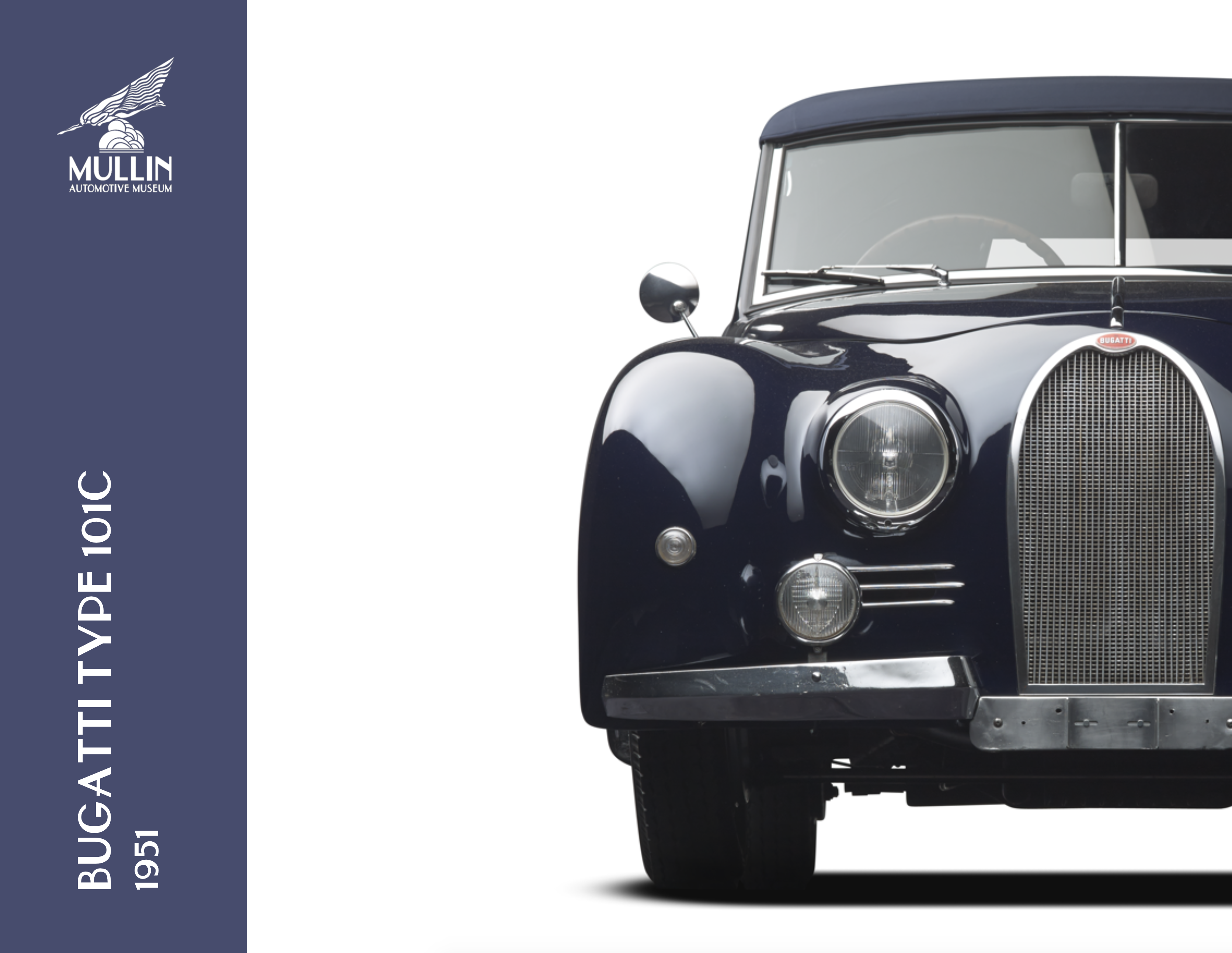
 Download PDF
Download PDF
